























Ford All- New Fiesta Zetec B&O PLAY with Driver Assistance Pack from only £195 * Advance Payment.
To find out more, visit ford.co.uk/motability or call 0345 60 40 019.
Official fuel consumption figures in mpg (l/100km) for the Ford All-New Fiesta Zetec B&O PLAY 1.0T EcoBoost 100PS 6 Speed are: urban 40.9 - 52.3 (6.9 -5.4), extra urban 67.3 - 78.5 (4.2 - 3.6), combined 54.3 - 65.7 (5.2 - 4.3). Official CO 2 emissions 118 - 97g/km. The mpg figures quoted are sourced from official EU-regulated test results (EU Directive and Regulation 692/2008), are provided for comparability purposes and may not reflect your actual driving experience.
* £195 Advance Payment available only on Ford All- New Fiesta Zetec B&O PLAY 1.0 EcoBoost 100PS 6 Speed. Driver Assistance Pack subject to availability. This programme is subject to the standard conditions of the Motability Scheme 3-year lease agreement. Full written details and quotations available on request from a Ford Authorised participating Dealer of Motability Operations Limited. Through the Motability Scheme the vehicles are leased from Motability Operations Limited ( Registered Company No. 1373876), City Gate House, 22 Southwark Bridge Road, London SE1 9HB. Applications must be received and accepted by Motability Operations Limited between 1st July and 30th September 2017.
FEATURES
14 IT’S A MANN’S WORLD
Olly Mann struggles to find a memorable quotation
Entertainment
22 DAME JOAN COLLINS INTERVIEW
The actress on glamour, movies and “old people”
32 “I REMEMBER”: KELLY HOPPEN
The successful interior designer on what drives her Health
40 FALSE MEMORIES
Uncovering the science behind this surprisingly common phenomenon
Inspire
60 HOW TO FEED A HUNGRY PLANET
Lab-grown meat, dried crickets and algae—are these our culinary future?
72 BEST OF BRITISH: WILD SWIMMING
Discover the best spots for an alfresco dip

80 SUMMER PHOTO COMPETITION
Enter your snaps for a chance to win a fabulous prize!
84 EXTRAORDINARY USES FOR ORDINARY THINGS
How to use milk to clean leather—and much more
Travel & Adventure
92 CARVED IN STONE
Photos of amazing monoliths from around the world
102 LOVE ON THE ROCKS
Michael Paterniti finds the island of Corsica to be both alluring and aloof

DIFFICULT to sustain a career in Hollywood for a few years—let alone a few decades. For that reason, Dame Joan Collins is truly unique: one of the longest-working actresses in the world, she continues to light up the big and small screens at the age of 84. We chat to her on p22 about how to remain glamorous—and why she’ll never end up in a care home.
Other things that have stood the test of time are the incredible monoliths around the world, pictured on p92. From South America to Egypt to the UK, these structures have survived thousands of years, and they’re all the more fascinating because we still don’t know what some of them mean.
Of course, history lives on in our memories—or does it? This month we also uncover the fascinating, and occasionally shocking, science behind false memories. It’s an unnervingly common phenomenon, so chances are it affects you too. Learn more on p40 and let us know your thoughts (before they turn into memories!).
 Fiona Hicks
theeditor@readersdigest.co.uk
facebook.com/readersdigestuk
twitter.com/readersdigestuk
Fiona Hicks
theeditor@readersdigest.co.uk
facebook.com/readersdigestuk
twitter.com/readersdigestuk

For a chance to win a SEBO vacuum cleaner, enter our monthly draw at: www.sebo.co.uk
SEBO is a world leader in professional vacuum cleaners, meaning we know all about making durable, high quality machines that clean exceptionally well and are designed to work. In fact we do such a good job that many flooring manufacturers only recommend SEBO.
So, if you want to upgrade your vacuum cleaner, choose the brand used by professionals – SEBO.
Simon Fulton | simon.fulton@readersdigest.co.uk
Mike Allen | mike.allen@readersdigest.co.uk
Kerry Schofield | kerry.schofield@readersdigest.co.uk
WE PAY...
£50 for the star letter and £30 for regular letters.
Email readersletters@readers digest.co.uk or go to readers digest.co.uk/contact-us
WE ALSO PAY...
£50 for the true stories, anecdotes, jokes in Laugh! and You Couldn’t Make It Up…, and contributions to end-ofarticle fillers and My Great Escape
Email excerpts@readersdigest.co.uk or go to readersdigest.co.uk/contact-us
We cannot acknowledge or return unpublished items or unsolicited article-length manuscripts. Do not send SAEs. Article-length stories, poetry and cartoons are not requested.
Contact Customer Services for renewals, gifts, address changes, payments, account information and all other enquiries. Call 0330 333 2220* or email customer_service@readersdigest.co.uk
Reader’s Digest is also available in audio and accessible etext editions from RNIB Newsagent, for blind and partially sighted readers. Call the RNIB Helpline on 0303 123 9999 or visit rnib.org.uk/newsagent
Visit readersdigest.co.uk or write to: Reader’s Digest, PO Box 7853, Ringwood BH24 9FH. UK: £45.48 a year. Republic of Ireland: €61.20 a year. Prices include delivery. For gift subscriptions, contact Customer Services.

Schools breaking up for summer means six weeks of finding fun-filled activities for the kids. In case you end up babysitting the little darlings while their parents are at work, we’ve collated some cheap and imaginative garden activities to make this summer with the grandchildren one to remember. Visit readersdigest.co.uk/summer-grandkids
Now the sunny days are finally here, you may be dusting off the barbecue and checking the expiration dates on your suncream. But some of our summer traditions are potentially harmful to our pets. Visit readersdigest.co.uk/protect-your-pet for our top tips on keeping your furry friends safe.
twitter.com/readersdigestuk

Planning a camping trip? These easy treats can all be made using an open fire. Enjoy!



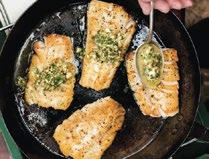
facebook.com/readersdigestuk
Get all the recipes at readersdigest.co.uk/ campfire-cooking
We pay £50 for Letter of the Month and £30 for all others
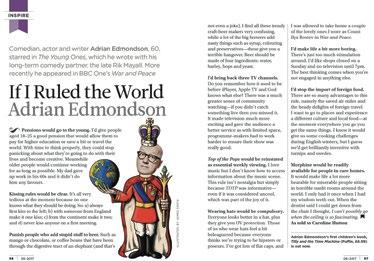
I agreed with Adrian Edmondson’s suggestion in “If I Ruled the World” that pensions should go to the young. Financially, young people are really suffering. Can they afford to go to university? Can they study a subject they love or must they study something that will make them more employable? Can they afford to travel? Oftentimes not, and yet travel is great for broadening horizons and fostering tolerance and respect of others.
Sadly, creativity doesn’t even come into the equation—but as the bedrock of happiness, it really should. The young need to be given space to explore the kind of life they’d like to lead and the kind of person they want to be. By providing them with a buffer zone, a pension would be a shrewd investment in our future—a topsy-turvy stroke of genius that would benefit society greatly. JENNIE GARDNER, Bath
I really enjoyed your “I Remember” feature with Tony Blackburn, and it brought back memories of when I was a young fan at just ten years old. I still have the autographed photo I requested from him at BBC Radio 1 and—even though he was never considered “cool” by my
friends—he was, and obviously still is, a genuinely nice guy.
It was interesting to learn more about his early career on Radio Caroline and I didn’t realise he was the first DJ on BBC Radio 1 in 1967. His own singing talents were a revelation too and, after a YouTube search for his Northern Soul offering,
I discovered Tony did have a reasonable voice and probably deserved a better chance at making music as well as playing it.
Smooth is the only radio station I usually listen to now but, as a result of your feature, I think I’ll have to take a trip down memory lane and tune into Tony on BBC Radio 2.
ANN JOHNSON, CheshireI loved your feature “Best of British: Small Islands”. From the Hebrides to the South Atlantic Ocean, it really is clear our fair nation extends far beyond our shores; I’m surprised at how many fascinating and unspoiled islands there are to discover. There’s always something a bit magical about stepping off the mainland to explore the outer reaches. I’m adding all your perfect offshore spots to my travel wish list.
DEE COLWORTH, CambridgeshireI read “The Power of the Paintbrush” with great interest. I used to express anger with watercolour painting. My pictures were kept under wraps because they concerned people— relatives and in-laws—dressed as outlaws who were “wanted”.
I then turned to using a pen, another form of art that allowed me to see the funny side of life, even when I found people frustrating! I submitted cartoons to newspapers and magazines for several years and made a nice bit of pin money on the side. Much of it made my better half happy and paid for her clothes and entertainment.
I am now 90 years old and can sit back with serenity, watching the world go by. I hope others who might read this letter will find that a limited vocabulary is no barrier to expression—and psychotherapy practised in joke form is quite a giggle.
ALAN ANDREWS, DevonI enjoyed the interview with Diane Keaton, “Just Don’t Judge”. Despite her successful film career, Diane has remained grounded and doesn’t display any diva-style demands attributed to so many other stars in Hollywood. Her quirky personality and self-deprecating nature make her one of my favourite actresses. She’s truly original—how can we forget her turning up at the 2004 Oscars ceremony in a three-piece suit and bowler hat?
MELANIE LODGE, West Yorkshire











I spend £2 a week on the lottery and just £1 a week on my funeral

I spend £2 a week on the lottery and just £1 a week on my funeral








You don’t have to trust luck if you want to leave a cash sum for your loved ones. One sure way is the Guaranteed Over 50 Plan.
You don’t have to trust luck if you want to leave a cash sum for your loved ones. One sure way is the Guaranteed Over 50 Plan.
From less than £4 a month – one of the lowest fixed premiums for a plan of this type – it could be just the ticket. And, if you’re aged 50-85, we guarantee we’ll accept you – no medical, no health questions asked.
From less than £4 a month – one of the lowest fixed premiums for a plan of this type – it could be just the ticket. And, if you’re aged 50-85, we guarantee we’ll accept you – no medical, no health questions asked.
As long as you continue to keep up your premiums, after you’ve had the plan for two years, we’ll pay out a fixed cash sum on your death. If you were to die in the first two years, we’d return all the premiums paid, plus half as much again. That’s unless you were to die as the result of an accident, when we would pay out the full cash sum.
As long as you continue to keep up your premiums, after you’ve had the plan for two years, we’ll pay out a fixed cash sum on your death. If you were to die in the first two years, we’d return all the premiums paid, plus half as much again. That’s unless you were to die as the result of an accident, when we would pay out the full cash sum.
When we say guaranteed, we mean it –so unlike the lottery, you know exactly how much will be paid out. Just bear in mind that inflation will reduce the value of your fixed cash sum over time. You should also be aware that, depending on how long you live, you could pay in more than the cash sum paid out. All we ask is that you keep paying your premiums for life. If you stop, your cover will end and you won’t get anything back.
When we say guaranteed, we mean it –so unlike the lottery, you know exactly how much will be paid out. Just bear in mind that inflation will reduce the value of your fixed cash sum over time. You should also be aware that, depending on how long you live, you could pay in more than the cash sum paid out. All we ask is that you keep paying your premiums for life. If you stop, your cover will end and you won’t get anything back.
Cover provided by AXA Wealth Ltd.
Cover provided by AXA Wealth Ltd.
Great reasons why more people choose SunLife
FREE £75 gift card
FREE £75 gift card
FREE £300 Funeral Benefit Option
FREE £300 Funeral Benefit Option
First month FREE!
First month FREE!
UK’s most affordable
UK’s most affordable
UK’s most popular**
UK’s most popular**
It’s your funeral – who’s going to pay?
It’s your funeral – who’s going to pay?
You may be surprised to know that the average cost of a funeral is £3,897,‡ and that’s likely to rise in the future. Paying less than £4 a month won’t cover all of your funeral costs, but it could help if you’re worried about leaving your loved ones with the bill.
You may be surprised to know that the average cost of a funeral is £3,897,‡ and that’s likely to rise in the future. Paying less than £4 a month won’t cover all of your funeral costs, but it could help if you’re worried about leaving your loved ones with the bill.
Get your information pack today
Finding out more couldn’t be easier. So why not call our UK call centre today to request your free information pack. We’ll also send you a free pen, just for enquiring.
Finding out more couldn’t be easier. So why not call our UK call centre today to request your free information pack. We’ll also send you a free pen, just for enquiring.
As a thank you for taking out a plan, your first month’s premium will be FREE and you’ll get a FREE £75 gift card.
As a thank you for taking out a plan, your first month’s premium will be FREE and you’ll get a FREE £75 gift card.
‡Source: Average of quotes for standard funeral arrangements from a sample of funeral directors. SunLife Cost of Dying Report, June 2016 (Critical Research). **Most popular whole of life guaranteed acceptance plan bought directly. ABI statistics – 12 months up to 31.12.2016. †Amazon.co.uk is not a sponsor of this campaign. For complete Gift Card terms and conditions, see www.amazon.co.uk/gc-legal. All Amazon ®, ™ & © are IP of Amazon.com, Inc. or its affiliates.
‡Source: Average of quotes for standard funeral arrangements from a sample of funeral directors. SunLife Cost of Dying Report, June 2016 (Critical Research). **Most popular whole of life guaranteed acceptance plan bought directly. ABI statistics – 12 months up to 31.12.2016. †Amazon.co.uk is not a sponsor of this campaign. For complete Gift Card terms and conditions, see www.amazon.co.uk/gc-legal. All Amazon ®, ™ & © are IP of Amazon.com, Inc. or its affiliates.
SunLife Limited distributes financial products and services and is a company limited by shares, registered office: 1 Wythall Green Way, Wythall, Birmingham, B47 6WG (registered in England, no. 05460862). SunLife Limited is authorised and regulated by the Financial Conduct Authority and is entered on the Financial Services Register (registration no. 769427).
SunLife Limited distributes financial products and services and is a company limited by shares, registered office: 1 Wythall Green Way, Wythall, Birmingham, B47 6WG (registered in England, no. 05460862). SunLife Limited is authorised and regulated by the Financial Conduct Authority and is entered on the Financial Services Register (registration no. 769427).





























A bit of wood, stucco, discarded tyres, cans and bottles—that’s about all New Mexico architect Michael Reynolds needs to build a house.
Since he began 46 years ago, he’s been converting refuse into refuges he calls “Earthships”, which all have one thing in common: they’re completely self-sustaining! Solar panels supply the houses with electricity, rain supplies the water, and the walls, which are largely constructed from those used tyres, effectively store heat. It’s good for the environment and the wallet!

This month Olly Mann must find a catchy quotation—but is he up to the task?

Olly Mann is a writer, radio presenter and serial podcaster, with shows including Answer Me This!, The Media Podcast and The Modern Mann
YOU DON’T SAY NO TO BBC RADIO 4. Their audience is enormous, their appearance fees are reasonable, and the profile boost from being on their shows is significant. So whatever Radio 4 ask me, I say yes. This has led me to pontificating on the show You and Yours about subjects which, frankly, I have no business discussing. Occasionally I’ve had to express an interest in books I would never actually choose to read, just to get on Front Row.
Considering this “agree first, worry later” approach, it’s a relief that I’ve never been invited on The Moral Maze, for which I’d be too jolly, or Any Questions?, for which I’d be too centrist. But I’d never considered Quote, Unquote as a poisoned chalice, until my agent rang to say that I was booked for it.
THIS PANEL GAME, which has been running since about 1843, seems at first glance a good fit: it’s a quiz about what famous people said and wrote (I studied literature), it’s gently amusing, rather than competitively comedic (I’m not a stand-up), and it’s resolutely aimed at middle England (I sound like the sort of guy you’d meet in a garden centre). But every recording starts with the long-standing host, Nigel Rees, asking each panelist to contribute their favourite quote.
This obligation made me nervous. I’m not the kind of person who collects quotes. I’m just not. I’ve read roughly

half of Dickens, seen almost all of Shakespeare, and watched every Woody Allen film, but if you ask me for a favourite quotation, I go blank. My mind simply doesn’t work that way. I can sing you, verbatim, every
lyric to every Supertramp single. But I don’t retain quotes.
The only quote I know—literally, the only one—is Mel Brooks on comedy: “Tragedy is when I cut my finger. Comedy is when you walk into
an open sewer and die.” I love how neatly it uncovers the DNA of laughing at another’s misfortune. I thought it would suffice as “my quote” in the opening round. But then, as a refresher tool for my appearance on the show, I downloaded the latest edition of Quote, Unquote—and was staggered to hear one of the panelists blurt out the very same line; my Mel Brooks quote.
Now I was in paroxysms of panic. I couldn’t turn up to the recording the next day with a quote that had been cited in the most recently broadcast episode. After a few unhappy hours googling “memorable quotes” (all of which were too well-known: “Nothing to fear but fear itself”; “We shall fight them on the beaches”; “Some of us are looking at the stars”, etc), I discovered a Facebook group devoted to wit and wisdom. Much of it I discarded as clickbait for housewives (“May your home be a place where friends meet, family gather, and love grows” and so forth), but one example stood out: “Be nice to nerds. Chances are you’ll end up working for one”—Bill Gates.
I was in paroxysms of panic—I couldn’t turn up to the recording with the quote that had already been cited felt funny
and fresh, and the sort of thing the producer might expect me—the youngest, most tech-savvy member of the panel—to say. By the time I reached the green room at the BBC Radio Theatre, I was quietly confident I had a decent opening gambit; victory snatched from the jaws of defeat.
A runner with a headset came down to tell us we had 15 minutes to show time, and it occurred to me that I didn’t know where Bill Gates had uttered this famous statement of his, and I should probably research into that, just in case it came up. So I conducted a quick search on my smartphone, and discovered that he HADN’T SAID IT AT ALL.
It turns out the line was actually part of an editorial piece by some bloke called Charles J Sykes, published in The San Diego Union-Tribune in 1996. It was falsely attributed to Bill Gates four years later as part of a muchforwarded “inspirational” email, and the internet has (mostly) believed it ever since.
I’d never heard that before, but it
My heart sank. I had nothing else in my arsenal. I knew that, instead of just kicking off the show with my
zinger, I would now have to qualify my quote with something like: “A-ha! But it wasn’t said by Bill Gates at all, it was actually some guy you’ve never heard of!”
Far from ideal. But I had no choice. As the recording began, I felt like perhaps I should have declined this invitation, after all.
SHOW was a treat: the other guests and the audience were lovely, and
the game was fun to play. As we walked off set, I said to fellow panelist Julian Mitchell (the octogenarian writer best known for Another Country) that the whole programme was so good-natured it felt as if we’d travelled back to the 1950s.
“Well, I was last on the show in the 1970s,” he replied. “And it was exactly the same then. Even the quotes were the same!”
Now, that’s a quote.
Believe it or not, these nuggets are all true:
“To travel from North Korea to Norway, you only have to go through one country.”
“If you push a living sponge through a fine mesh screen, it’ll rearrange itself in a few hours.”
“The whole of Australia could fit comfortably into the Sahara Desert— with plenty of room to spare.”
“Pirates wore eye patches so one eye would always be acclimatised to the dark, allowing them to see in the darkness below decks in an instant.”
“From a botanical standpoint, strawberries and raspberries aren’t berries— but bananas and avocados are.”
“Redheads require more anaesthesia than non-redheads.”
“Penguins have glands under their eyes to extract and secrete excess salt. These are powerful enough to allow them to drink seawater as their primary water source.”
“Ketchup was sold as medicine in the 1830s.”
SOURCE: REDDIT.COM





































But

Gtech’s Grass Trimmer uses a high performance 18V motor, giving you the power to cut and edge the lawn – without a cord to hold you back. But the main thing you will notice is the weight. At only 1.75kg it is incredibly easy to manoeuvre, putting less strain on your arms and back.
Designed for comfort and ease of use, the trimmer features an adjustable handle for perfect balance. Equipped with a one-handed power trigger and safety switch to prevent accidental starting, it is simple to operate.
The trimmer is powered by a Lithium-ion battery, giving you up to 30 minutes run-time* with a charge time of just 4 hours. If you need more time, then spare batteries are available from Gtech, and better still, they are interchangeable with the Gtech HT20 Cordless Hedge Trimmer.

















FREE blades for life‡











With a twist of the cutting head the trimmer easily converts to a precision edger, allowing you to give your lawn a neat nish.
Don’t worry about the cost of replacement blades. Your Cordless Grass Trimmer comes with 20 easy change blades, but Gtech also offer free spare blades for the life of the product.
Part of the new Gtech garden power tools range
The Gtech Grass Trimmer is part of a cordless power tool range, launched in spring 2016. The Grass Trimmer is accompanied by lightweight Lithium-ion Hedge Trimmer and powerful Cordless Mower. Call or see website for details.
Don’t just take our word for it...
We really do care what you think about us. Go online to see the thousands of independent reviews our customers have given us; and do check out our product videos at www.gtech.co.uk.

■ drama maudie If there’s one film this year that’ll make you want to be a better person through its sheer wholesomeness, Maudie is it. Set against the stern but gorgeous Nova Scotian landscape, the film revolves around Maud—a gentle soul with a passion for painting, who suffers from a debilitating illness. Eager to break free from her controlling aunt, she applies for a job as a maid to a gruff, antisocial fish peddler. The boss-employee relationship—which starts as a volatile dynamic crippled by insecurity—blossoms into a loving, nurturing union. Sally Hawkins and Ethan Hawke portray this couple caught in an avalanche of emotion, both good and bad, with enormous empathy—always resurfacing with undeterred spirit.
■ fantasy: a ghost story It begins the way it usually does: there’s a boy and a girl, they’re in love, there’s some conflict—and then one of them dies. What follows is a profound meditation on grief, life and time. Rooney Mara and Casey Affleck star in this incredibly original, ineffably moving ghost story whose ethereal nature is akin to a freeverse poem. You’ll think you know where it’s going but— trust us—you have no idea.

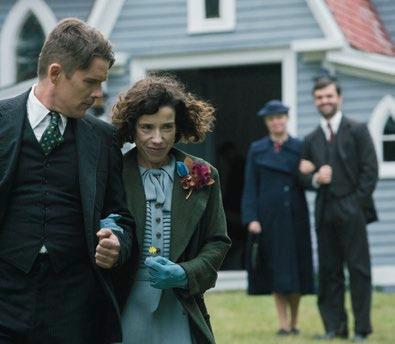
■ comedy: the hitman’s bodyguard
Ryan Reynolds is the world’s top bodyguard tasked with protecting Samuel L Jackson’s notorious hitman on his way from England to the International Court of Justice. Oh, and they just happen to be mortal enemies. A hilarious nod to the Whitney Houston classic—full of explosions, gunshots and high-speed car chases, along with small but feisty performances from Gary Oldman and Salma Hayek.


■ biography: england is mine
A nostalgic throwback to Seventies’ Manchester, focusing on the early life of Steven Patrick Morrissey before he went on to become the lead singer of the groundbreaking band The Smiths. Mimicking the mood of its subject matter, the film is half-glum, halfhilarious, packed with sardonic humour and the restlessness that comes with pursuing a career as an artist. A treat for any music fan.
■ action: the dark tower After years of anticipation and numerous production delays, the high-scale adaptation of Stephen King’s iconic Dark Tower book series is finally here.
Idris Elba stars as Roland Deschain, a gunslinger on a mission to protect the mythical structure of The Dark Tower.
Matthew McConaughey is his nemesis, Walter Padick—or the menacing “Man in Black”. The film engulfs you in a fantastical, head-spinning multiverse filled with creatures and characters from King’s many beloved works.

Watching: the Football league show (channel 5)
An entertaining and enjoyable look back on Saturday’s EFL league football matches.

Reading: my Colourful life: From red to amber by ginger mccain An autobiography written with great passion and humour.
l
Online: ernest hemingway’s life and work I love to research new facts about the great man, his life and his amazing writing.
istening: in time: the best of r.e.m. 1988–2003 An important band to many. This album features most of their finest work.
Fancy appearing in this section? Send your current cultural favourites, along with short descriptions, to readersletters@readersdigest.co.uk
Paranormal by Alice Cooper
All hail The Godfather of Shock Rock whose new record
Album of the Month
Paranormal is the epitome of everything we love about summer music, whether it’s taking your car out on the open road and blasting your favourite tunes or dancing away at a festival. This highenergy beast of an album is brimming with testosterone-fuelled guitar riffs, classic horror filminspired antics and guest appearances from rock music royalty, such as ZZ Top’s Billy Gibbons and U2’s Larry Mullen. With blood, guts and alcohol aplenty, Paranormal is fan service at its best (69-year-old Cooper still singing about “tricked out Cadillacs full of party girls” is oddly comforting), but it also features some deliciously rugged, oldschool blues-rock numbers such as “Dead Flies” and “Fallen in Love”. To top it all off, we’re treated to a mini-reunion of the original Alice Cooper band members, marking the first time they’ve recorded together since the Seventies. Key tracks: “Paranormal”, “Dead Flies”, “Rats”

Like this? yoU may aLso Like... shout at the devil by mötley crüe One of the many bands influenced by Cooper, Mötley Crüe struck gold with this hook-driven 1983 classic. The record became a heavy metal staple, with its naughty lyrics and occult symbolism stirring up a lot of controversy at the time.

On Our Radar
scarborough cricket festival, august 6–9. Spend a relaxing summer afternoon watching first-class county cricket. Visit discoveryorkshire coast.com for details. bristol
international balloon fiesta, august 10–13.
Enjoy the stunning spectacle of over 150 hot air balloons taking to the sky. Visit visitbristol. co.uk for details.
summer nights film festival in nottingham, august 24–28.
Revisit your favourite cinema classics under the stars. Visit experience nottinghamshire.com for details.
Dynasty diva Dame Joan Collins talks to Fiona Hicks about ageing, acting and why you should always keep up appearances

“I
“TERRIBLE”. She doesn’t divulge why, but a quick check of her busy Twitter feed reveals that I’m meeting her in a week when the ceiling of her luxury London apartment has collapsed, due to a water leak in her upstairs neighbour’s flat.
A terrible situation indeed— but there’s no making do for Dame Joan. She’s holed up in Claridges and, despite the upheaval, still manages to look divine.
We’re here to discuss her latest film, The Time of Their Lives. In it she plays ageing, down-and-out movie star Helen Shelley, who makes an unlikely friend in downtrodden housewife Priscilla (played by Upstairs, Downstairs’ Pauline Collins). Together the duo hop-foot it to France for a weekend of age-defying adventures.
“It was a fabulous role,” says Joan who, before this script came along, hadn’t appeared in a film for three years. “She’s a very interesting character in so many ways.”
“I don’t think it’s likely that I’ll find myself in a nursing home. Although maybe it is, the way I feel right now,” she states, with a slightly bitter laugh. “But I have a family, children, grandchildren, a wonderful husband…” she tails off, implying that none of these people would relinquish her to care.
People need to take better care in their youth and middle age so they don’t fall apart when they turn 70
It’s a role that seems made for her. In fact, sometimes it’s hard to know when the beautiful, strong-willed fictional star ends and Joan begins— but a crucial difference is that at the beginning of the film, Helen Shelley lives in a nursing home. Not so for 84-year-old Joan.
“I went to two care homes [to prepare for the film], to see how they were, these old people. I don’t know how to say this without attacking the NHS— well, it’s not the NHS, but some of them seemed somnambulistic. The people just sat there; they didn’t have any vitality.”
The more she talks, the more the winsome, slightly coquettish Joan Collins who’s appeared on the big and small screen for more than six decades begins to emerge. It’s clear that she doesn’t relate to these “old people” in the slightest.
“Anybody has a duty to look after themselves, so that they don’t have to expect to be looked after,” she says, straightening a little. “People need to

take better care in their youth and middle age, so that they don’t fall apart when they turn 65 or 70.”
At 84, Joan captivates in her latest film, The Time of Their Lives
Joan herself still exercises religiously, two or three times a week. “If you continue to do something, you’re not going to lose it just because you get older. I don’t feel any physically different to when I was 45. I tell my husband, who’s 51—I think, I never remember—that he’s got to exercise more, because I exercise more than he does.”
Joan’s husband, her fifth, is Percy
Gibson. They married in 2002 and are still going strong, despite the media furore about the age gap. He was there at the start of the interview, as it happens, making sure his wife was happy and settled.
OF COURSE, DAME JOAN IS USED TO THE SCRUTINY. Since moving to Hollywood in the Fifties, her life has played out in the public eye. “When I came under contract to 20th Century Fox when I was 20, it was just coming to the end of the golden age in which


the studios had total control over their stars. There would be one man—I don’t want to say Donald Trump-ish— who was totally controlling of their studio.
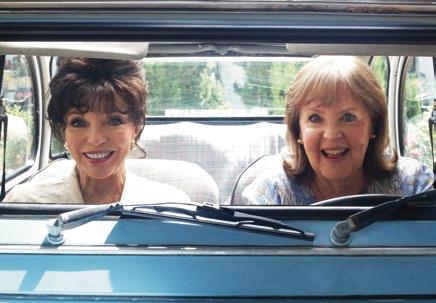
is Joan’s first film role in three years ©
“I was told what movies to be in, I was given beautiful clothes—my experience was very positive. I worked with Paul Newman, Bette Davis, Richard Burton…I just took it all for granted.”
Considering this illustrious record, it’s interesting that her advice to young people wanting to enter the industry now would be, “Don’t. It’s the toughest, hardest, most vicious profession in the world. Out of every one person who becomes Eddie Redmayne or Tom


Although she’s enjoyed her decadeslong career, Joan calls acting “the most vicious profession in the world”
Hiddleston or Emma Watson, there are thousands and thousands of others who are waiting tables. It’s incredibly competitive and you have to have a huge amount of luck.
“Sometimes I see things on television and I think, How did that person get that job? They’re really bad. A lot of it is luck, because it certainly isn’t talent.”
Joan’s own career has been “very up and down”. After a hopeful start, appearing in The Girl in the Red Velvet Swing, The Opposite Sex and Island in the Sun, she never quite made it to studio-favourite status, famously losing the role of Cleopatra to Elizabeth Taylor (“That’s when the studio started to go downhill,” she quips). After taking a few years out to raise her three children, she had bitparts until she hit the big time again in the Eighties, playing the wilful and

glamorous Alexis Carrington in TV series, Dynasty.
It’s the part that would define her career, and to some degree, her—as the perfectly coiffed image of Joan is one that was cemented during those heady years of TV success. She famously did her own make-up for the part, and has since released her own line of cosmetics.
“I think taking care of your appearance is very important,” she
“I DO WHAT I LIKE”
says, fixing me with that arresting wide-eyed stare. “You present yourself, or at least you should, in the way you want the world to see you. My aunts and my grandmother and my mother were all extremely glamorous. In the Forties and Fifties people didn’t go around in jeans with their knees sticking out and t-shirts with slogans. That doesn’t mean I don’t have jeans—not with holes in the knee though.”
HER IMAGE HAS CERTAINLY CONTRIBUTED TO HER ENDURING APPEAL, and the public’s fascination with her. Looking back on her life, Joan says, “Other than the fact that I managed to raise three children— none of whom became drug addicts or committed suicide or became alcoholics, which is what a lot of
children of famous people do—I’m most proud of the fact that I’m almost the longest-working actress in film.”
She gestures to a picture of Doris Day on the wall. “She’s alive, but she’s not working. Sophia [Loren] isn’t working, but she started after me anyway. I’m quite proud of that.”
So what does she feel she has left to achieve?
“I couldn’t call myself a driven person,” she muses. “I do what I like.” She flashes that movie-star smile, her collapsed ceiling obviously forgotten for a moment.
“I just enjoy life—I’d like to keep on living.”
The Time of Their Lives is available now on DVD.
Korean barista Kangbin Lee creates works of art from people’s morning coffee



NOMINATED FOR BEST NEW COMEDY OLIVIER AWARD IT’D BE CRIMINAL TO MISS IT!

AND 3-COURSE MEAL
















We’re o ering a special deal to Reader’s Digest readers of £59.50 for a show ticket and a 3-course meal with wine at Brasserie Zédel.
Book now for the hottest show in town.
MischiefTheatre.co.uk/ReadersDigest
2016 London Cast. Photography by Darren Bell | This package includes a Band A ticket (usually up to £52.50) to see The Comedy About A Bank Robbery and a threecourse meal from the Formule menu at Brasserie Zédel including co ee, water and a glass of house wine, valid for Tuesday to Friday and both Sunday performances until 31 March 2018, subject to availability. For full terms and conditions visit
MischiefTheatre.co.uk/ReadersDigest

Reader’s Digest is offering you eight best-selling products from the Joan Collins Timeless Beauty range—usually worth over £109—at an exclusive discounted rate. Get them now and indulge your senses. *plus


Kelly Hoppen MBE, 58, is an interior designer, author and businesswoman. She’s also a TV personality, having appeared in Dragon’s Den and The Great Interior Design Challenge
…WHEN WE MOVED TO LONDON [from South Africa] I was three or four and our first home was in Sloane Street. It was a very big apartment— we had huge bedrooms, a large nursery, a long corridor and there was a stained-glass window in the entrance hall. I used to run into my parents’ bedroom every night—I had nightmares that these little men would come out of the stained-glass window and follow me into my room.
…MY BROTHER AND I HAD VIVID IMAGINATIONS. We’d play games in which we’d create make-believe scenes, like theatre sets. One was an airport and we were at the check-in.

We’d check people in and we’d have fake boarding passes and we’d give them vouchers for “delays”, which happened to us a lot. The other game we used to play was drycleaners. I used to get clothes from my mum, pin the numbers on, put them in plastic and hang them on wire hangers.
We had a great love of the same music and Michael will, to this day, get an album, say “track one” and I’ll know exactly which bit he means.
…BOTH MY PARENTS WORKED, so it was a very normal family and my brother and I got on well. He’s two years older than me; we had



a very special relationship growing up. My parents had a lot of friends and entertained a great deal. We were always included in that, so we had a fantastic upbringing.
…WE USED TO GO BACK TO SOUTH AFRICA every Christmas until I was 16. Christmas in Cape Town was heaven. We’d go for a good three weeks in total and always stay at my grandparents’ home in Constantia, which was stunning. It was all about family time, beach days, family lunches, seeing cousins, catching up with friends. We went to pool parties and listened to the radio, as there were no TVs in those days. We spent evenings at drive-in movies and then used to head to the
Dairy Den for ice cream! My first kiss, first love and first drink all happened over those Christmases—it was the happiest time of year for me.
…LOVING THE WAY PEOPLE FELT IN MY GRANDPARENTS’ HOME. It wasn’t the style but the way they welcomed people into their home. My parents’ home was also beautiful, so I was always surrounded by good taste. My mum used to take me to see show flats on weekends, which I loved.
…I DIDN’T ENJOY SCHOOL. I was bullied there but I had some close friends from outside school. My brother went to boarding school when he was quite young so I was

kind of an only child at home. I hated it but it was what it was. On the other hand, it was also sort of great because I’d want to go out with every one of his best friends...it’s always handy having an older brother.
Kelly didn’t enjoy school, but remembers a “fantastic” upbringing and adolescence

was in my blood.
DIGEST I ever saw. I was obsessed with one page in it, which was the before-and-after pictures [of a room] and I knew then that I wanted to do it. The first time I designed a room I was 13. I had a very pink bedroom and my brother and I swapped bedrooms and I designed it—with a cream shag-pile carpet, brown felt walls trimmed with chrome and modern furniture. I was always
APARTHEID when I was young, but I knew instinctively that it was wrong—and the older I became, the more it abhorred me. It was one of the reasons I stopped going back to South Africa.
I remember I went back when my father died [Kelly’s father passed away when she was 16] and I made friends with a mixed-race band called Pacific Express. I toured with them and got into trouble because apartheid was rife, and for me to be with black or mixed-raced friends was simply not allowed. It was such

As a young woman, Kelly returned to South Africa and toured with the band Pacific Express
a horrific thing to come to terms with. They were the nicest people and some of the happiest times I had were spent with them. It’s something I’ll never forget—atrocious politics.
…I WAS COMMISSIONED BY A FAMILY FRIEND to do a kitchen— my first proper interior-design job. It was a standard kitchen from start to finish and it was a disaster because the client was an alcoholic. But it was a good lesson and I knew nothing could frighten me. From there I got a fantastic job at the racing driver Guy Edwards’s home.
I was tenacious and worked hard to build my business. You define your life—you can’t lie on your back and wait for it to happen.

…PETER JONES IN DRAGON’S DEN putting a mask on his face. It was my first week of filming and I lost it laughing, and I thought, Are they going to fire me? But then Deborah Meaden started to laugh, then Duncan Bannatyne—everybody was hysterical. Peter didn’t think it was that funny so I put the mask on, and then he laughed.
…GETTING A LETTER ON A FRIDAY that I didn’t open until the Monday—it must have been in a brown envelope. Being dyslexic, I read it and thought, What does that say? And then I re-read and realised I’d got an MBE. That night, I was very emotional and I called my mum and my kids. They were over the moon.

My mum said, “Darling, don’t tell anybody, they won’t give it to you”, but I’d already told 20 people. It’s so exciting, you can’t not.
It was an amazing day. We had a lunch and a party in the evening and Rory Bremner gave a talk about MBEs (“makes beige exciting”). It was great.

…GETTING DIVORCED WAS A TOUGH TIME. Ed [Miller, Kelly’s second husband] and I didn’t fall out of love—it was just circumstances, with him getting involved with a cult abroad. It was a difficult time. Also, I would say the death of my father when I was 16 was very hard. These times make you stronger and they define who you are; you go through them and good times come again.
…MY MOTHER HAS SAID the thing that makes her most proud of me is that Ed and I brought up our family for 16 years. Ed became like a father

Clockwise from above left: with friend Lord Bruce Dundas; harnessing her trademark hair; with daughter Natasha
to my daughter, Natasha, because she doesn’t see her own dad, and I became a stepmother (and still am) to his girls.
Jo, who’s Sienna Miller and Savannah Miller’s mother, was very sick with cancer when I first met Ed, so the kids came to live with us. There was an enormous bond between us and there still is. Jo was an amazing stepmother to my daughter too. We had a very unusual family that seemed quite strange, especially all those years ago. But we’re very blessed. We still go away as a family group on summer holidays.
…I RECEIVED LETTERS FROM MY FATHER when I was travelling in which he said that we Hoppens aren’t demonstrative enough. He said you have to show your love, care for people and do unto others what you would have done to you.
Kelly and her daughter Natasha, now a chef and food blogger, posed for a portrait to support WaterAid’s Deliver Life Appeal in 2015

You have to stay calm and focused and you’ve got to live life to the full. I think it’s because my dad died when I was very young that I’ve always had that mentality.
I remember Alexandra Shulman [the former editor of Vogue magazine] once said to me, “I’ve got a dress from Gucci and it’s just sitting in my wardrobe—I’m waiting for a special day to wear it but I’ve waited a year now.”
I said, “Why wait? If you’ve got something and you love it, wear it today.”
It’s like with anything in life, today’s the day—you never know what’s going to happen. As told to Joy Persaud
To view and purchase Kelly Hoppen designs, visit kellyhoppen.com
One elderly lady had a gracious way of getting her own back:
“I was at the post office one day when an senior lady in front of me asked for a single stamp. Obviously considering this a waste of her time, the woman behind the counter made a snorting noise, ripped off a stamp and flicked it across the counter, where it landed on the floor. She didn’t apologise or offer the lady another stamp. The old lady paused for a second, picked up the stamp and left her 65 pence on the floor in its place. She said a cheery, “Thank you!” and walked out—and the woman behind the counter had to walk around to pick up the money.”
SOURCE: BOREDPANDA.COM



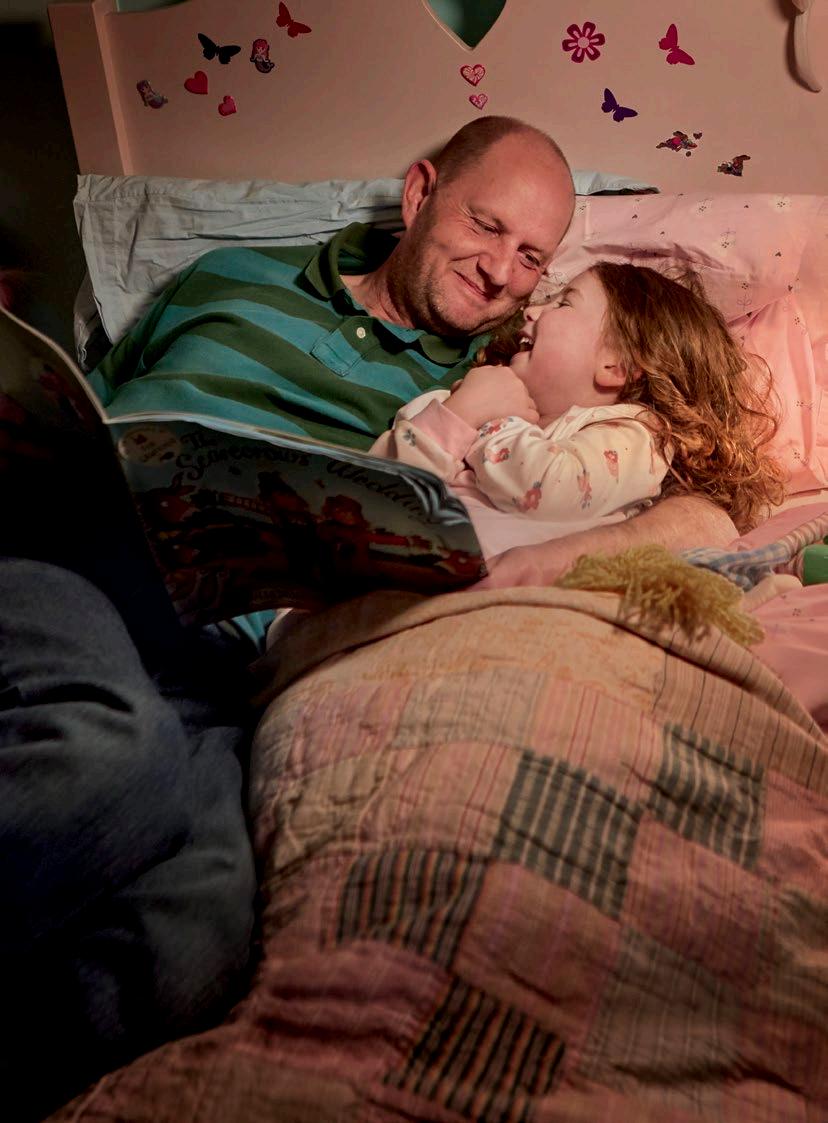





Think you can trust your recollections?
Think again. Scientists are uncovering the shockingly common phenomenon of…


room IN a daz E. After 25 hours of intense questioning, he’d just signed a confession confirming that he’d brutally murdered his own mother, 51-year-old Barbara Gibbons.
“We got into an argument,” he told interrogators. “I remember picking up the straight razor, and I slashed towards her throat.”
Just a day after Barbara’s body was found, the murder was an open and shut case. Based on his confession, a jury sentenced Peter to between six and 16 years in prison. The only problem? He was innocent.
The teenager’s memory of his mother’s murder—of killing his only known relative with a razor with which he crafted model aeroplanes—was entirely false. In 1975, two years after his conviction, Peter was set free, exonerated by evidence that proved he couldn’t have been at the scene of the crime. He was never retried.
By claiming that he’d failed a lie-detector test and mental illness had likely caused him to “black out” the crime, the interrogators had convinced Peter— by all accounts a quiet, good-natured boy who loved his mother dearly— that he must have been the killer.
interrogators, he eventually provided detailed memories of the attack, explaining both his motive (his mother was an alcoholic who rarely showed him affection) and plan for disposing of the weapon (throwing it behind the nearby petrol station).
So why did this young man from a sleepy town in Connecticut confess to a crime he never committed?
False memory plays a role in 70 per cent of The Innocence Project’s overturned convictions
The Innocence Project movement in the US, which seeks to exonerate innocent convicts through modern DNA testing, says false memory plays a role in more than 70 per cent of the wrongful convictions they overturn. In ten per cent of those cases, their clients originally pleaded guilty, serving an average of 14 years for crimes that they didn’t commit.
Not only did Peter believe his
Dr Julia Shaw is a criminal psychologist at London Southbank University and the author of popular psychology book, The Memory Illusion. She conducts research into how and why our brains form these complex false memories. It’s a phenomenon, she
explains, that’s far more common than we might imagine.
“We like to think we’re able to distinguish between imagination and experiences, but the brain can’t actually do this very well. Certainly not once you’ve pictured what a fantasy might feel, smell or taste like. Then you’re adding in the markers we usually use to separate fact and fiction, and you’re making them indistinguishable.”
Our brains are home to approximately 86 billion neurons. Each of these neurons is equipped with stringy arms called dendrites, which allow them to stretch out to other cells. Each dendrite has “spines”, which act like brainy fingers, enabling them to reach out across synapses and communicate from one cell to another. Memories are formed when particular connections between these neurons are strengthened. Unfortunately for us, false memories and real memories seem to rely on the exact same mechanisms to become lodged in the brain.
It’s tempting to think of memory as a personal CCTV system, recording everything we see or do. In actuality, as the founder of applied memory science Professor Elizabeth Loftus explains, it’s more like a Wikipedia page. “You can go in there and change it, but so can other people”.
When we recall a memory, we aren’t flipping through the Rolodex of our minds to produce the correct

Peter Reilly pictured the weekend after his conviction. He owed his eventual freedom in part to a generous donation from playwright Arthur Miller
file—we’re writing that file out anew. We actively recreate our memories every time we think of them, adding room for potential fabrication or misremembering each time.
Think about your earliest memory. Perhaps you remember the birth of a sibling, your first taste of birthday cake or a traumatic trip to the dentist. Maybe you’re even one of the few who can recall their own birth. Well, if any of those memories occurred before you turned three years old, bad news: they’re definitely false.
As Dr Shaw explains, it’s physically
“Memory hacker” Dr Julia Shaw claims she can implant false memories of committing a crime in 70 per cent of people

impossible for our brains to form long-lasting memories when we’re that young. “Almost everybody thinks they have a memory from childhood that’s actually impossible.”
These false childhood memories are often caused by a process called “memory conformity”, where details we’ve learned through the accounts of others can implant entirely false memories, or lead us to accept the experiences
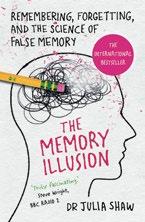
of others as our own. Perhaps you remember telling someone a story about yourself, only to realise that it had actually happened to them. That’s memory conformity.
THIs PHENomENoN has serious implications for the criminal justice system. If eyewitness accounts can mutate through discussion or the process of
remembering itself, then their reliability becomes compromised. And research has shown that emotional memories are no less vulnerable to fabrication. In fact, because we tend to be more confident about our memories of emotional or traumatic events, they can be even less reliable than their humdrum counterparts.
Not only are false memories possible, psychologists have proved that they can actually create false memories, hacking into our brains to implant recollections of events that never really took place.
Dr Shaw is one such psychologist. “I get people to repeatedly imagine committing a crime—theft, assault or assault with a weapon and police contact— and after three interviews using leading techniques and imagination exercises, we see that 70 per cent of them accept that they’re guilty of a crime that they didn’t commit.”
actually died. Far from it. She soon discovered that hundreds of people across the world shared the same richly detailed false memory.
So what causes these eerily similar collective false memories? On her website, Fiona Broome speculates that we’re all “sliding between parallel realities…that somehow have glitches”. She’s proposing a version of the quantum mechanic “multiverse” theory, which speculates that there could be many possible universes all existing simultaneously.
Almost everybody thinks that they have a memory from childhood that is impossible
But not everybody accepts the explanation that false memories are a by-product of our imperfect brains. Fiona Broome, a paranormal consultant from Florida, coined the term “The Mandela Effect” in 2010 when she realised she wasn’t the only person to remember Nelson Mandela’s funeral, 30 years before he
Multiverse theory was hypothesised to explain physics experiments, not false memories, but nevertheless, Mandela Effect enthusiasts enjoy speculating that their false memories are windows between worlds, not simple human errors.
Professor Chris
French, of Goldsmiths University’s Anomalistic Psychology Research Unit, is sceptical.
“We have a tendency to put ourselves at the centre of the action and I think that explains a lot about the so-called Mandela Effect. We all knew Mandela had a long sentence and many assumed he’d die in prison. Perhaps some people thought about it, imagined it happening and subsequently became convinced.
“False memories can arise without

To see how easily the brain creates false memories, try this test on a friend.
read them the following list of words: bed, rest, awake, tired, dream, wake, snooze, blanket, doze, slumber, snore, nap, peace, yawn, drowsy.
a minute later, ask them to recall the words. if one of their remembered words is “sleep”, congratulations— you’ve just successfully implanted a false memory by association.
from the study Creating False Memories: Remembering Words Not Presented In Lists by henry l roedigger iii and kathleen
B mcDermottanyone deliberately implanting them. Take the crashing-memories paradigm. Studies have shown that if you ask a random sample of British people if they saw the footage of Princess Diana’s car crashing in Paris, about 50 per cent will say they did, when in actuality, no such footage exists.”
Perhaps another explanation is that those who experience the Mandela Effect are particularly susceptible to false memories. As a paranormal psychology specialist, Professor French has worked on many studies examining connections between a belief in the paranormal and a predisposition to form false memories.
“Anything that’s likely to make you confuse something you’ve imagined with something that really happened makes you susceptible to false memories,” he explains. “Fantasy proneness, being creative, having a vivid imagination or simply, as my grandma would put it, a tendency to be away with the fairies.”
So what does the future hold for false-memory science? Developments in optogenetics, a technique that modifies brain cells to make them sensitive to light, and then uses laser beams to target specific memories, have already successfully implanted false memories in mice. Susumu Tonegawa, a neuroscientist at the RIKEN-MIT Centre for Neural Circuit Genetics and the researcher behind the trial, hopes
future findings will help to alert legal experts as to the unreliability of eyewitness accounts.
Dr Shaw explains that optogenetic research is now going a step further, with groundbreaking applications. “My French colleagues are doing some of that work on humans, trying to cut out trauma from the memories of veterans. So in extreme cases, there are potential future applications for severe PTSD. It’s very invasive, though, as you’re physically modifying the brain, so it’s definitely a last resort.”
These rapid developments are raising a host of moral concerns for researchers.
“The idea that techniques could be developed that would reliably allow the powerful manipulation of memory raises a host of tricky ethical issues,” explains Professor French. “There are no easy answers, but it would be wise for such issues to be discussed by everyone—not just scientists—sooner rather than later.
research relates to the criminal justice system and educating our law enforcers on the subject.
“A lot of police don’t know about this. A lot of lawyers. It’s shocking,” Shaw states. “It should be part of their core curriculum. The fact that there isn’t even a one-hour lecture on false memories for lawyers is absurd.”
Now 62, PETEr rEIlly works as a car-parts salesman in Tolland County, Connecticut, but he remains interested in cases similar to his own, sometimes taking time off to attend court hearings.
Memory is rightly considered fundamental to our sense of who we are
In an interview with The New York Times in 1997, Peter explained, “I’d just as soon forget and move on, but it’s such an important issue and it could affect anybody. I have a responsibility to make people aware.” More than 40 years on, the mystery of his mother’s murder remains unsolved.
“Memory is rightly considered fundamental to our sense of who we are and many people instinctively feel it’s wrong to interfere with a person’s sense of self, even if they consent.”
Nevertheless, one of the most important focuses of future memory
Accepting that our memories are vulnerable and that our past is always a fiction (to some degree) doesn’t have to be depressing.
“In some way, if you remove the weight that people often place on their past, it’s freeing—it’s quite Zen,” says Dr Shaw. “We’re storytellers, and what matters is now. Accepting that only makes us stronger.”

Susannah is twice winner of the Guild of Health Writers
Best Consumer Magazine Health Feature

To DEET or not to DEET? That’s the question facing gardeners, holidaymakers and anyone looking for protection from mozzies. Recent US research confirms this chemical, commonly used in over-the-counter bug products, is more effective than anything else at keeping away the biters. But some people worry it could be toxic to humans.
WHY ARE PEOPLE CONCERNED? Questions were first raised in 1989 when four children and one adult had seizures after using a spray containing DEET. Other research suggested that it could lower sperm count, while lab rats exposed to the chemical were shown in some studies to suffer brain damage. It’s thought that it could affect the central nervous system.
SCARY! SO WHY USE DEET IN THAT CASE?
First and foremost, because it works. Mosquitoes and other bugs track down humans through their antennae and DEET is thought to block the signal. In some regions of the world, the risk of contracting a mosquito-borne illness is greater than the risk from this chemical. Secondly, other research has proved reassuring. Scientists from the London School of Hygiene and Tropical Medicine found no link with DEET. There have


only been 14 reported cases of DEET-associated brain disorders since 1957, despite around 200 million annual applications of the repellent.
A DEET-BASED BUG SPRAY? Yes, all the studies emphasise that it’s safe if users follow label instructions. Most critically, keep DEET away from your eyes and mouth; there’s no question that ingesting large amounts can cause seizures. But if you’re using it in small amounts, you shouldn’t be affected in any adverse way and you could be spared some nasty mozzie bites.
I STILL DON’T
SOUND OF
WHAT ARE THE ALTERNATIVES? As nice as natural insect repellents sound, most aren’t much good. Wrist bands impregnated with bug-repellent are also widely considered useless. However, the research early this year from the New Mexico State University, which pronounced DEET effective, also found that sprays containing PMD—also known as lemon eucalyptus— were pretty handy too.
1 Isn’t that a garden pest? No, it’s a common foot complaint causing agonising heel pain when a thick band of tissue, known as the plantar fascia, connecting the heel with the foot is damaged.
2 When identifying the cause, the operative phrase is “too much”. Too much running or dancing, too much time spent in high heels or flip flops, too much time standing or simply too much weight.
3 Elaine Paige is a famed sufferer, having spent a lifetime in eyewateringly high heels. Angelina Jolie and Paris Hilton are also afflicted.
4 Most cases get better within a year. See your doctor or podiatrist, who can recommend stretching exercises.
5 You can relieve heel pain after wear by using painkillers and an ice pack wrapped up in a towel.

YOU GET A FULL BODY WORKOUT. It would take you 45 minutes exercising on land to do the same amount of good as you can do in 30 minutes in the water.
IT HELPS YOU LOSE WEIGHT. Even a gentle swim can burn 200 calories in half an hour. Paddle vigorously and you’ll burn even more.

It’s gentle on your joints because it’s a non-weight-bearing exercise, and the water supports you.
YOU’LL GET FIT WITHOUT GETTING SWEATY. All that water sloshing around will keep you cool in the pool. And although chlorine might not be your favourite perfume, at least you won’t have to wash your eau de BO-infused kit.
IT’S KIND TO YOUR JOINTS. Swimming is the perfect activity if you’re injured, have arthritis, or aren’t very mobile for other reasons.
IT’S GOOD FOR YOUR MENTAL HEALTH. Regular light swimming will reduce stress levels and relieve anxiety and depression. And it’s a lot better for you than popping pills.
YOU’LL SLEEP BETTER AT NIGHT. Doing lengths of the pool will not only help you to chill out, but it will also wear you out. After all that hard work, you should sleep like a baby.
Want to feel more content? Happiness does grow on trees! A growing body of research proves that spending time outdoors has a feel-good effect. Blood pressure, heart rate and stress hormones drop when we’re enjoying nature.











If you are looking for a daily supplement to give you extra support from within, Jointace® has been specially formulated by Vitabiotics’ experts to provide premium nutritional care. With a unique combination of nutrients, and vitamin C which contributes to normal collagen formation for the normal function of bone and cartilage. Also available, Jointace® Gel, an advanced massage gel designed to help maintain healthy joints and muscles.
The signs of sunburn might not show immediately—in fact it can take up to 48 hours before the redness appears. You might even have headaches, nausea, fever and chills if it’s particularly bad. So what should you do to minimise the soreness and help the healing process?
• Get out of the sun immediately.
• Take a cool bath or shower, or apply a cold compress to areas where the skin is angry.
• Drink plenty of water to rehydrate.
• Use an unscented moisturiser or aloe vera cream to soothe your skin.
• Try an over-the-counter hydrocortisone cream to reduce any inflammation.
• Take paracetamol or ibuprofen to relieve pain.
• Cover up and stay out of the sun until your skin has healed. That includes avoiding sunlight through windows.
• Remember that prevention is always better than cure, so make sure you always use adequate sunscreen with an SPF of at least 30 and stay out of the sun in the middle of the day where possible.
Let’s make this your last sunburn ever!
Ask your wife to take a good look at you in the buff. That may sound a bit racy but there’s a very sensible reason why: a new study from the American Academy of Dermatology found that women are nine times more likely to find a melanoma than men. At the same time, men over 50 have a higher risk than the general population of developing skin cancer. So it makes perfect sense for men to get their partner to check their skin for changes.
Here’s what you should both be looking for:
• Begin with the back and trunk. These are the most common sites for men to develop melanoma.
• Check the head and neck, where melanoma is also often found in men. Take a peek at his scalp while hair is still wet.
• Look anywhere the sun strikes in warmer weather, including shoulders, arms and legs.

Examine areas that are always covered, including bum and groin, as it’s possible to get skin cancer on parts that aren’t exposed to the sun.
Don’t forget hands and feet. Palms and soles are common problem areas, especially for people with darker skin.

Christadelphians believe the Bible is the Word of God and outlines the great plan that God has for the world and individuals through the saving work of the Lord Jesus Christ.
It is sad to note, that in many areas the Bible’s clear teaching has been altered in ways that render the true Christian message confusing and in some cases unintelligible.
This book A Challenge to all Christians asks the reader to seriously look at where they stand in relation to the message of Christianity as originally taught by the Lord Jesus. It is incumbent on all Christians to “earnestly contend for the faith which was once for all delivered to the saints” (Jude 3).





To obtain your FREE copy please send your name and address

Fiona studies
Naturopathic Nutrition at the College of Naturopathic Medicine, and is a member of the Nutrition Society
NOT ONLY DO THEY ADD FLAVOUR YOUR MEALS, fresh herbs and spices can support your health too.
OREGANO A favourite herb in Mediterranean dishes, this contains special oils that help to stop the growth of harmful bacteria in your gut. Try adding a few springs of fresh oregano to a bottle of olive oil to infuse it with the aromatic flavour.
THYME A study has shown that thymol, a compound in this evergreen, supports the proper structure and functioning of cells in the brain, kidneys and heart. Keep yourself sprightly by sprinkling some thyme leaves on your scrambled eggs.
New research suggests that tea can help fight Alzheimer’s disease and dementia. A study involving 957 Chinese seniors aged 55 and older found that regular tea consumption correlated with a 50 per cent reduction in the risk of cognitive decline, rising to 86 per cent in those who carry a gene that makes them especially susceptible. Black, green or oolong teas are all effective, providing they’re brewed from tea leaves.


PARSLEY Many people know that this humble European herb can freshen breath when chewed, but few know that it may also be protective against cancer. In one animal study, parsley was found to inhibit tumour formation in the lungs. Perhaps you should eat that parsley garnish!
GINSENG It may not be a regular in your kitchen, but this root is well worth including in your diet. In a trial conducted at the UK’s Brain Performance and Nutrition Research Centre, a 400mg dose was found to improve calmness and mental arithmetic skills in healthy adults. Not sure about cooking with it? The root can simply be sliced and infused in hot water for a refreshing tea.
ALOE VERA Often used as a topical remedy for sunburn, this can help soothe your insides too. A small-scale trial conducted in 2013 found that a daily consumption of aloe vera juice was associated with reduced abdominal pain and discomfort in patients with IBS. Even if you don’t suffer from irritable bowel syndrome, aloe vera juice can also help to encourage beneficial gut bacteria.
CORIANDER Key to many Asian and Mexican dishes, this fragrant leaf has been the subject of several studies. In animals it was found to lower levels of “bad” cholesterol while raising levels of “good” cholesterol. Try mixing with fresh tomatoes, onions and lime juice for a delicious (and quick) salsa dip.

Max is a hospital doctor, author and newspaper columnist
“THIS IS YOUR LAST CHANCE,” warned Mrs Gillfeather. I broke out in a sweat and my hands started to shake. We both wanted to get to sleep, but before we could, I had to put a cannula in her arm.
Before becoming a doctor I’d only a vague idea, stemming from an hour spent with a plastic arm while at medical school, what a cannula was. Once I became a fully fledged doctor, however, I couldn’t seem to get away from them.
For those of you who are lucky enough to have never come into contact with one, they’re tiny little tubes that are put into a vein so that fluid or medicines can go directly into the blood. That’s the theory. Unfortunately, the problem is that for them to work, you have to get them into the vein in the first place. This tends to be trickier than you’d imagine— and it’s a job that tends to fall on the junior doctors.
THE FIRST THING YOU HAVE TO DO is choose a suitable vein. All the junior doctors I know have their own personal favourites. Pure panic ensues when you’re confronted with a patient whose anatomy deviates from the norm, or who has a layer of fat covering your vein so you can’t see or feel it. Then you have a choice—either try to find another one somewhere else, or just stab the needle in and hope you hit gold (well, blood).

Once in a vein, there’s a little window at the back of the needle that fills with blood so you know you’re in, and then you slide the tube of the needle and into the vein. But Mrs Gillfeather’s veins were being particularly elusive that evening. I’d been jabbing the needle in for at least 20 minutes.
“Isn’t there someone else who could do this?” she asked, for the fourth time. “Someone who knows what they’re doing, perhaps,” she said under her breath, just loud enough for me to hear. I suspected that Mrs Gillfeather was going to make sure there was blood that evening—but not hers.
Because so many of my nights on call were spent putting cannulas in, I became rather obsessed. I was transfixed when, on trains or buses or out shopping, I saw large, ropey
veins running up someone’s arm, engorged with blood—just ready for me to effortlessly slip a cannula into. I developed a rather disconcerting habit of tentatively assessing the ones that run over the wrist by carefully squeezing them when I shook people’s hands. This led to people assuming I’d joined the Masons, but I couldn’t help myself.
I GOT IT IN. Mrs Gillfeather and I both breathed a sigh of relief.
Just as I was about to leave the ward, the nurse called me over, “Max, there’s another cannula to do on bed 16.”
I made my way over to his bed and gently woke Mr Marshall. “I’m the doctor,” I said, and shook his hand.
He looked down at his hand as I shook it and then up at me. “Are you a Mason or something?” he asked.
Broadly speaking, anaemia means a lack of red blood cells. There are various things that can cause this, but the most common is due to a lack of iron. This mineral is needed to make an important part of red blood cells called haemoglobin, which is what helps the red blood cells transport oxygen around the body. Without enough iron, oxygen can’t be transported properly, leading to symptoms such as feeling weak, short of breath, tired or looking pale.
Unless you’re pregnant or eat a very restricted diet, it’s uncommon for it to be caused simply by not having enough iron in your diet. The main cause is the body losing blood faster than it can make it—and the most common cause is bleeding in the stomach or intestines. It can also be caused by stomach or bowel cancer, or heavy periods in women. It’s important to have the cause investigated so your doctor can treat it appropriately.

Once the cause of the iron deficiency has been established, doctors will often prescribe a course of iron supplements. These are stronger than shop-bought versions and are very effective.
It’s important to go for the regular blood tests while the iron levels improve. Tea, coffee, milk and dairy products, walnuts and almonds all reduce the body’s ability to absorb iron, so avoid these. Dark green leafy vegetables, meat and pulses are all good sources of iron, so you should eat plenty of these.
BY DAVID HUMPHRIESIn the aftermath of the recent devastating terror attacks in London and Manchester, people across the country have united to support and help each other.
The generosity and kindness shown by the public has been overwhelming.
By donating to our UK Solidarity Fund, you can help victims of terror attacks in this country.
Please donate now to show that they are not alone.

You won’t receive any marketing calls from the British Red Cross as a result of this donation. *Texts cost £10 plus standard network rate (we receive the full 100%). For full T&Cs visit redcross.org.uk/mobile
Following the terror attacks in Manchester and London, the British Red Cross has set up a fund to support those affected by these events and similar events in the future in the UK. For more information, visit www.redcross.org.uk.
The British Red Cross Society, incorporated by Royal Charter 1908, is a charity registered in England and Wales (220949), Scotland (SC037738) and Isle of Man (0752).
By 2040, the world’s population is predicted to rise to nine billion—and we all need to eat. Enter a new generation of bright ideas, novel protein sources and radical farmers


IN MARCH THIS YEAR, A SAN FRANCISCO STARTUP ANNOUNCED THAT THEY’D GROWN THE WORLD’S FIRST CHICKEN AND DUCK MEAT IN A LAB. After isolating poultry stem cells, Memphis Meats scientists had managed to grow them in a culture of sugars and minerals in bioreactor tanks. After six weeks, the meat was large enough to harvest.
“It was a historic moment for the clean meat movement. We’re developing a way to produce meat without the need to feed, breed and slaughter actual animals,” says Uma Valeti, a former cardiologist and co-founder of Memphis Meats. “Meat as a product is delicious but the current meat production process has some serious problems for the environment, animal welfare and public health. We need to completely change the way it gets to the plate.”
Demand for meat is predicted to double in the next 20 years. Yet raising animals for consumption causes pollution, deforestation and uses up staggering amounts of water and feed. “Worldwide, some 70 billion farm animals eat a third of our cereal harvest, 90 per cent of our soybean meal and 30 per cent of our global fish catch—precious resources that could be fed to billions of hungry people,” says Philip Lymbery, author of Farmageddon: The True Cost of Cheap Meat.
Experts agree that we must find a more sustainable source of protein. Indeed, Henning Steinfeld of the Food and Agriculture Organisation of the UN has described how beef is going to become “the caviar of the future”.
36% OF THE WORLD’S CROPS ARE FED TO LIVESTOCK
In a recent US poll, one in three said they’d be happy to eat lab-grown meat and the race is on to find a way to mass produce a tasty, affordable product. Poultry is due to become the world’s most popular meat by 2020 and Memphis Meats aim to have their “featherless” chicken meat on sale the following year.
In February, 50,000 seeds from countries as diverse as Benin, India, Pakistan, Lebanon, Bosnia and Herzegovina, Mexico, the Netherlands, the US, Belarus and the UK were ferried to an indestructible mountainside vault on a remote island in the Arctic Circle.
The Svalbard Global Seed Vault, which opened in 2008, holds duplicates of seeds held in gene banks across the planet. It’s safeguarding 4.5 million varieties of crops, protecting them for future generations in the event of natural or man-made disasters.
“Despite political and economic differences, collective efforts to conserve crop diversity and produce a global food supply for tomorrow are strong,” says Marie Haga, executive director of the Crop Trust, the international organisation tasked with ensuring that crop varieties are protected.

She adds, “We still have a fabulous natural diversity of crops around the world—including 125,000 varieties of wheat and 200,000 varieties of rice. We’ve by no means unlocked the potential of these crops. Crop diversity will be crucial in developing climate-resilient crops for many generations to come.”
Virus-resistant sweet potato, floodtolerant rice and maize with inbuilt pesticide are just some of the new genetically modified (GM) plants scientists have created to increase global food production.
Of course GM food—where scientists “cut and paste” one or more genes with desirable traits from one plant into another—is highly controversial. While the USA, Brazil, Argentina, Canada and China grow substantial amounts of GM food for human consumption, Britain, the EU, New Zealand and Japan do not.
Dr Prakash, professor of crop genetics, genomics and biotechnology at Tuskegee University in Alabama, urges, “With a growing world population and volatile climate changes ahead, humanity must
harness various options to ensure sustainable food production. Biotechnology tools including GMO will be potent in developing resilient crops varieties that could be grown in the face of drought, flooding, salinity and pests and diseases finding new ranges. Humanity would benefit greatly.”
For example, erratic rains frequently flood rice-growing areas in India, Bangladesh and Nepal, ruining crops and leading millions to starve. In response to this, the International Rice Research Institute has developed a strain that can survive underwater for over two weeks.
Twenty to 40 per cent of global crop totals are lost annually to disease and pests. “Right now wheat is being threatened by Ug99, a new, very damaging wheat steam rust which originated in Uganda. It’s already spread to 13 countries and could wipe out crops in Asia,” Dr Prakash says. “Labs across the world are working to build a resistance to Ug99 into some wheat varieties.
“Human beings, since the dawn of civilisation, have been meddling with nature to provide food—agricultural
FLOODING DESTROYS ENOUGH RICE TO FEED 30 MILLION PEOPLE EVERY YEAR

Crickets could soon become a common snack in the UK
biotechnology is just another extension of that.”
Regarding the safety of GM foods, he says, “There hasn’t been a single instance of known harm from the use of GM crops or food that are on market now—neither to the consumer nor the environment.”
He further shares his view: “I would like to see governments in Europe, Asia and Africa support investment and commercialisation of agricultural biotechnologies, and do more to help the public understand the safety and benefits of these technologies.”
Mealworm canapé, bug ice cream or deep-fried locust anyone? Experts are looking at ways to persuade us to conquer our squeamishness and get our protein from bugs instead of meat. Indeed, some upmarket department stores and trendy London restaurants are already serving up six-legged critters.
Insects are a valuable source of protein to 2 million people across the developing world, from Central and South America to Africa and Asia. In his TED talk, “Why not eat insects?”, Professor Marcel Dicke, an ecological entomologist from the Netherlands’ University of Wageningen, says, “Two billion people in the world already eat insects and regard them as a delicacy—as we think of shrimps and crabs.”
variety,” says Professor Dicke.
Insect-farming uses up a fraction of the land, water and feed compared to traditional livestock. Bugs also produce less greenhouse gases and convert their feed into food more efficiently. “Ten kilos of feed produces one kilo of beef—or nine kilos of locust,” states Professor Dicke.
But could entomophagy (the consumption of insects) really take off in the UK? Thringill Farm in Cumbria is the UK’s first ever edibleinsect farm, housing up to a million chirping crickets in plastic storage containers kept at at least 25C. By the end of the summer, they hope to be ready to sell whole dried crickets and a “nutty” tasting high-protein cricket flour for use in food products such as biscuits and energy bars.
As global meat and fish resources come under increasing pressure and prices soar, he says that many more humans (and livestock) should get their protein from lower down the food chain. Many edible insects provide all nine essential amino acids, plus an array of micronutrients including iron, zinc and magnesium.
There are many environmental advantages. “Insects are more abundant than we are. There are 6 million species—that’s a huge
The challenges are not just to grow more food, but also food that’s more nutritious. This is particularly crucial for the developing world, where two billion rural poor are deficient in essential vitamins and minerals— often because their staple crops provide so little nutrition.
Over the past decade, great strides have been made by using a process called “biofortification” to add nutrients to various food crops. This
can sometimes be done by selective plant breeding—but where a plant is difficult to breed or doesn’t contain the desired vitamin or mineral at the start, GM biofortification is used.
The following crops are already being grown: vitamin A-enriched sweet potato in Angola, high-iron beans in Brazil and lentils with extra zinc in India. Meanwhile, many other biofortified crops are being tested across the world from Mexico to Syria and Nepal.
One of the biggest challenges facing food scientists is the grave vitamin A deficiency, which is a major cause of childhood mortality in 90 countries and causes up to 500,000 children to go blind every year.
Dr Prakash explains,
saying, “I hope Bangladesh and the Philippines complete their tests soon and permit farmers to grow this biofortified crop. With the advent of genomics and gene editing, I hope we’ll see further rapid development of biofortified crops. They’re the most efficient way to address micronutrient deficiency in the developing world.”
“Rice is a staple food for nearly half the world’s population and there are 100,000 varieties—but not a single one contains any beta-carotene, which our bodies need to make vitamin A. The only way we can add beta-carotene to a rice crop is through genetic engineering.”
“Golden Rice” has been created by inserting genes from maize to make it produce high levels of beta-carotene. Unfortunately, recent trials in India reported that crossing GM Golden Rice with an Indian variety had resulted in stunted growth.
But Dr Prakash remains optimistic,
Experts believe that algae (which range from giant seaweed to tiny colourful microscopic cells) could be one of the most nutrient-rich foods on earth—and an excellent source of protein. You may already be familiar with spirulina powders and pills in our health shops.
“Algae are tiny, single-cell organisms that use solar energy to produce nutritious biomass containing proteins, fatty acids, vitamins and minerals,” explains Professor Mark Edwards, a world expert in sustainable food based at Arizona State University.
“Algae are eaten by everything from the tiniest shrimp to the great blue whales. They’re the base of all life and will support our abundant food future.”
This ancient life form grows in
adverse conditions including extreme temperatures, drought and salinity. “Algae grow using minimal or no fertile soil, fresh water, fossil fuels, inorganic fertilisers or pesticides and thrive in places such as deserts and non-arable land that would kill crops,” says Professor Edwards.
Where freshwater is scarce, microalgae can be grown in brine water or even treated waste water. There are already hundreds of rural spirulina microfarms in Africa, Asia and Latin America. Dried spirulina has the texture of crunchy noodles, a slightly marine flavour and can be ground into powder and added to food and drink.

(such as soya or tofu), delivers three times the protein of a kilo of beef, at half the cost. But algae will make the biggest difference to world food supplies by providing stronger nutrition for crops and livestock.”
“By 2040, I predict that algae-based foods will replace 40 per cent of meat products and 60 per cent of the soy, corn and wheat products we use today,” says Professor Edwards. “A kilo of algae-based meat substitute
Entrepreneurs are also looking at ways to grow algae in urban places. “Imagine living in cities where the buildings are covered with photosynthetic membranes and vertical gardens, collecting the sun’s energy and producing food for urban citizens,” says Robert Henrikson of Smart Microfarms, a US-based company that installs microalgae systems in community and urban gardens. “In the future, remote monitoring and smart technology will make it possible to deploy containerised microfarms anywhere in the world.”
Imagine yourself relaxing on a warm, sandy beach with the sweet smell of sugar cane and tropical fruits carried by a a gentle breeze. Your evenings are spent sampling the local cuisines on terraces overlooking the ocean—and all is well with the world

On a World Cruise, you can sail between the hemispheres following the heat of the sun and keeping the thrill of summer close. Reader’s Digest Cruise Club can make this dream a reality—and at the best price possible.
On a World Cruise, you can retrace the paths of history’s greatest explorers and watch in wonder as the world drifts away beyond the vast Atlantic or sparkling Pacific waves.
Mix crumbling European columns with soaring, ancient pyramids, and let tropical
Caribbean islands meet exotic, oriental temples.
With Reader’s Digest Cruise Club, there’s a huge variety of destinations to choose from, meaning you can explore a full World Cruise on your luxurious ship, while benefiting from shorter routes around specific regions.
With the option to skip any parts of the cruise that don’t appeal to you, you can tailor your holiday to meet your needs; simply fly to another destination or spend your time inland. Rejoin the cruise adventure at any stage, in any port around the world. Everything will be taken care of.

This year, Reader’s Digest Cruise Club is offering you the chance to finally do it; to to make your dream a reality and visit all the places you’ve been yearning for.
You can discover the cultures you’ve always longed to experience; you’ll enrich your life by immersing your in new customs, traditions and lifestyles, meeting people you’ve always wanted to.
If not now, then when? By joining the Reader’s Digest Cruise Club for free, you have our travel experts on your side, to get you the best deals and create your dream getaway.



Writer Matt Haig’s, 42, moving account about coming through depression, Reasons to Stay Alive, was last year’s second best-selling non-fiction book
I’d put mental health at the forefront of the agenda. What’s more important than the state of our minds? It’s how we interact with and change the world. But, although things are getting a bit better, it’s still seen as a slightly tacked-on issue, often hushed up and rather taboo. I’d make it an integral part of government policy on education, employment and general health.
I’d ban cars. People might hate me at first but it wouldn’t take long for everyone to see the psychological and environmental benefits. It’s not healthy for us to spend long periods cooped up in a small closed container, sitting in traffic jams getting angry with the world. We’d walk more without cars, we’d be more social and better off too.
I’d radically rethink schools. The high level of stress we put on our children is terrible. We need to create nurturing environments with more natural learning



patterns. Testing children every step of the way doesn’t make for more useful employees down the line— indeed, it makes them associate learning and books with highly pressurised environments. How did we get it so wrong?
There would be drinking venues for non-drinkers. As someone who goes through periods without alcohol, I’d like to be able to go to the equivalent of a pub or wine bar without the beer or wine. Friends would gather, the atmosphere would be great and the drinks delicious.
No advertising would be aimed at children. Before I wrote for children I wrote business and marketing books, so I understand both sides and know what advertisers try to do. They’re very sophisticated and generally want us to feel dissatisfied so they can sell us the “solution”. For adults this might make us worried about ageing or hair colour, but for children it’s more about peer pressure. We’re raising the thresholds for happiness too high, so legislation on advertising should be much more stringent.
We’d have a three-day weekend and no work emails would be allowed. As a freelancer I don’t have to stick to a five-day working week, but I do know that I work harder if I have to get something done in a shorter amount of time. I’ve got a lot more
productive since our children were born! Our brains aren’t supposed to work all the time, it’s not natural. I don’t think the economy would suffer—in fact, more leisure time means more money spent. I sometimes wonder whether crazy binge drinking happens because we have such a short amount of time to enjoy ourselves each week.
I’d get rid of Twitter. This is hypocritical as I do tweet a lot, but that’s because it’s highly addictive. When you send a tweet you worry about the response—will it go down well or badly? Then you check how many “likes” you’ve got and the whole thing becomes compulsive. During periods when I’m not tweeting I feel really good about myself, so in my utopia it simply wouldn’t exist.
I’d remind people that the bottom of the valley doesn’t have the clearest view. When my depression was at its worst in my 20s, I wish I’d understood that there are always better moments ahead. Life has peaks and troughs— it’s not just a downward slope. I was confused and worried about so many things back then. Two of the many positives of getting older are a sense of perspective and the wisdom to worry less.
As told to Caroline Hutton
Matt Haig’s new novel How to Stop Time (Canongate, £12.99) is out now.

Make a splash this summer with our pick of Britain’s best spots for an outdoor swim
BY ANNA WALKER
Crummock Water is a designated “quiet lake”, which means swimmers can enjoy the peaceful spot without interruption from noisy powerboats (even canoes require a permit here).
Visitor experience manager Jessie Binns explains that the water is also one of England’s most pristine lakes. “There’s virtually no nitrate pollution, which means you get incredible visibility in crystal clear water—the local diving club report seeing freshwater sponges growing on the underwater crags, so the lake’s also a site of special scientific interest.” Visit at the right time and you’ll also swim surrounded by carpets of bluebells.
Crummock is perhaps best viewed on a misty morning, as steam rises from the water, kingfishers hunt and families of wild otters can be spotted on the banks.
■ Visit lakedistrict.gov.uk/ swimming for more information




So beloved are the swimming ponds of Hampstead that when the council tried to close them in 2004, locals ensured the case was taken to the high court, and promptly overruled.
Three of the park’s 30 ponds are open to the public, each fed by the
Pond swimmers enjoy some sunshine at the Heath

River Fleet—a men’s pool, women’s pool (the only wild women’s-only pool in the UK), and one for everyone to share.
Says Bob Warnock, Hampstead Heath’s superintendent, “Although the Heath is only four miles from central London, you’re transported to a countryside oasis from the
moment you arrive. With swimming companions of ducks, moorhens and coots at the ponds, and kingfishers nesting nearby, you can get close to nature and enjoy a sublime and peaceful experience, which is good for body and soul.”
■ Visit cityoflondon.gov.uk for more information
Perched on the edge of some particularly pretty woodland, Hanmer Mere gets rather warm during the summer months, with the water reaching a toasty 20C in August.
Says Dianne Parish, founder of the Chester Frosties open-water social group, “Hanmer is a delightful village and the locals are very friendly. They give us a big smile and wave, with some amusement in the winter months. At the top of the village there’s a cosy pub with roaring real log fires where we retreat to reheat.”
The group’s most frequent Hamner swimmer, Jackie, says, “I’d have been lost without this as my ice-swimming training pool. We respect the peaceful location and swim in small groups to respect the wishes of the locals, ensuring we maintain the safety of the wildlife habitats.”
■ Contact dianne@dianneparrish. com for more information



Fans of Scottish Loch Lomond’s gentle waters say, “There’s nothing more exhilarating than taking the plunge”.
Rosemary Lowne, of the loch’s swimming and triathlon club, explains that the spot is “truly breathtaking on dry land, but even more so once you’re fully immersed in the fresh water, where the beautiful views take on a deeper meaning.”
Loch Lomond is the biggest loch in Britain

Despite being the biggest loch in Britain, Lomond’s varying depths mean swimmers of all abilities can take it on. Fancy a challenge? Each August it’s home to the Great Scottish Swim, where global participants—including Bavaria’s Ice Swimming World Championship medallists—flock in their hundreds to raise money for charity.
Look out for the colony of wallabies who’ve been hopping around the park since the 1940s, and the herds of deer that made it a favourite hunting spot for King James I in the 15th century.
■ Visit lomondtri.com for details
Formed at the end of the last Ice Age and nestled away in the heart of Delamere forest, this haven for wildlife is home to over 13 species of dragonfly (including the rare hairy variety), which merrily skim the waters as locals swim past.
Wildlife also thrives under Hatchmere’s surface, making it a popular spot for angling. Quiet, hopeful fishermen sit to lure in bream, pike, roach and carp, so it’s best to stick to the designated swimming zones. Get lucky and you may be joined by the stately Great Crested Grebe, which can often be found gliding through the mere.
Hatchmere resident Pete has been swimming here since he moved to the village five years ago, and he’s always found it “a surprisingly tranquil swimming location”. Be cautious as the approach turns boggy after rainfall.
■ Visit hatchmere.com for more information


from the main bridge to escape the eyes of visitors to Chatsworth House, and meander down the grassy bank to access the most private body of water.
This stretch is wide and deep, with its easy course only disrupted by a few gentle bends.

Chatsworth House has been home to the Cavendish family since 1549
Expect company from trout, grayling and brook lampreys and moos of approval from the nearby fields of cows.
This wild dip would make Mr Darcy himself proud. The River Derwent, which runs through the spectacular Chatsworth Estate, is known the world over as the backdrop for Mr Darcy’s Pemberley in the 2005 adaptation of Pride and Prejudice. Take short stroll downstream away
Feeling adventurous? Here you can swing across the water Tarzanstyle or make a splash from one of several tree swings.
Wet shirt and brooding expression not required.
■ Visit xtramileevents.com for upcoming Chatsworth triathlons

This idyllic stretch of the River Cam has tempted some of Britain’s finest literary minds—including Rupert Brooke, Virginia Woolf and E M Forster—into her waters.
The literary set, who dubbed themselves the “Cambridge neopagans”, swam nude under the stars and camped outside overnight, enjoying the river that Woolf said smelled like “mint and mud”.
Punters and bankside picnickers will keep you company as you swim the velvety clean waters, which peak at 22C in the summer months.
You can swim here for free, but join the nearby Newnham Riverbank Club for £16 a year and you can swim au naturel in their private section. Neat hedges shield paying members from the prying eyes of the general public. Total freedom!
■ Visit camconservancy.org/ swimming for details
Know your depth
• Shallow water can deepen unexpectedly. Survey the area carefully before you begin. Don’t jump or dive but wade in slowly and stay close to the shore.
• When swimming in cold water, enter gradually, splashing your pulse points, neck and back before immersing your shoulders.
Know your water quality
• Avoid swimming if you see bluegreen algae in the water as it can trigger skin rashes, stomach upsets and sore eyes.
• Never swim in canals, locks, urban rivers or floodwater. Be cautious of water quality during droughts.
Know your equipment
• Consider wearing a wetsuit and waterproof shoes to keep warm, with a colourful swimming hat to increase your visibility.
• Cover any cuts with a waterproof plaster and take warm clothes to change into afterwards.
Know your limits
• If your teeth begin to chatter, get out of the water as soon as possible. Star jumps or press-ups are the best way to get warm fast.
• Know how you’ll get out of the water before you get in and never swim alone.
Visit environment.data.gov.uk/bwq/ profiles for more information on bathing water quality across the UK
Do you have a favourite open-water swim route? Email readersletters@ readersdigest.co.uk and tell us about it!
Send us your summer snaps—and you could win a fabulous camera!
THE ENTRIES ARE POURING IN for our summer photo competition— and there’s still time to submit yours!
All we ask is that you capture an image that represents summer to you. Perhaps it’s a walk with the dog at sunset, a melting ice cream in your grandchild’s hand, or even your partner enjoying a cold beer on holiday! Whatever it may be, we’d love to see it.
The photos will be judged by the Reader’s Digest editorial team and professional photographer James Eckersley. The winning entries will be published in our October edition.





Unsure about how to take a good photo? Here are some tips to help you feel confident:
Take a simple approach. One or two points of interest in your photo are plenty. It makes it obvious to the observer what they should be looking at.
Look at the background. Is there a rubbish bin there? A car driving past? Or even a stranger picking his nose? Don’t let an inopportune moment spoil your image.
If in doubt, get close. A frame that’s filled with your subject—rather than one that’s surrounded by lots of wasted space—makes for a much more engaging image.
Be patient. You might not get it right the first time, but the beauty of digital cameras and smartphones is that you can take lots more. You might even discover a new passion!
Panasonic Lumix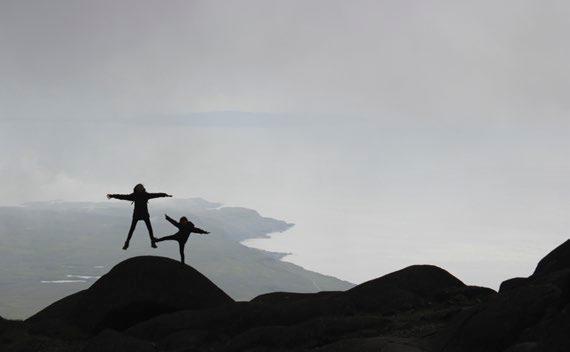
Above and right: previous winners of the adults category. Both images impressed judges with their simplicity and clever perspective

J Take a high-resolution photo with either a phone or digital camera. After saving it as a jpeg no larger than 2MB, go to readersdigest.co.uk/photo-comp and use the form to upload. Entries must be submitted by 5pm on August 24.
J There are two categories—one for adults and one for under-18s. The adults prize is a Nikon DSLR Camera worth £750; the under-18s prize is a Panasonic Lumix Bridge Camera worth £230.
J Please mark your entry either “Adult” or “Under 18”.
RULES: Please ensure that pictures are original, not previously published and taken specifically for this competition. If you’re under 16, you must ask your parent or guardian’s permission to enter this competition. We may use entries in all print and electronic media. Contributions become world copyright of Vivat Direct Ltd (t/a Reader’s Digest).
Entry is open only to residents of the UK, Channel Islands, Isle of Man and Republic of Ireland. It is not open to employees of Vivat Direct Ltd (t/a Reader’s Digest), its subsidiary companies and all other persons associated with this competition, their immediate families and relatives living in an employee’s household.
The judges’ decision is final. n
















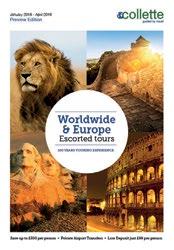






















It’s a breeze to finish chores, carry out repairs and clean messes using common items you already own
BY KELSEY KLOSSALUMINIUM FOIL SCRUBS POTS
CLEAN. No scourer? Use aluminium foil as a temporary replacement. Crumple a handful and scrub to polish stainless steel pots (foil may damage non-stick pots).

SOAP SCUM. Conventional cleaners don’t dissolve stubborn soap build-up on shower doors. Spray the glass with cooking spray and leave for 30 minutes. The oil slides between the glass and the soap


scum, making it easy to wash. Wipe off with soapy water (or a wet sponge with a drop of dishwashing liquid).
SPONGES REMOVE PET HAIR. Fido leaving your furniture furry? Lightly dampen a sponge and rub it across upholstery. It will easily lift pet hair from the surface.
AMMONIA CLEANS THE OVEN. For almost effortless oven cleaning, fill a bowl with ammonia and set it in an unheated oven overnight; remove the bowl the next day. The ammonia’s fumes will have loosened the gunk so you can wipe it off with a wet sponge or paper towel.
LEMON JUICE LIFTS INK STAINS. Soak an ink stain in lemon juice for five to ten minutes before washing in a normal cycle. The juice’s citric acid is a natural stain fighter that breaks up the ink on clothing.

PILLOWCASES PROTECT DELICATES. The washing machine can pull fragile jumpers and tights out of shape. Toss them in a pillowcase. Close the case with a rubber band, place in the drum and run the machine on a gentle setting.
SUGAR REMOVES GRASS STAINS. Enzymes in sugar help break down the chlorophyll that causes green stains. Mix 50g sugar with just enough warm water to create a paste. Apply to the stain. Let sit for 30 minutes before washing.
MILK POLISHES LEATHER. To clean patent leather (the glossy type used for belts, shoes and bags), dip a soft cotton cloth into milk. Gently buff the leather in circular motions to moisturise. The milk’s enzymes and fat soften and polish the leather. Buff again with a clean, dry cloth to remove remaining milk residue.
VEGETABLE SHORTENING REMOVES
LIPSTICK STAINS. Rub a dab into the lipstick mark, and wash as usual. The oil acts as a solvent to loosen the stain.
SPONGES PRESERVE SOAP
SPONGES PRESERVE SOAP. To help a bar of soap last longer, leave it on a sponge next to the sink. The sponge will prevent slime and drips by helping soap dry faster.

HAIRSPRAY PROTECTS ARTWORK.
When your mini Picasso brings home a masterpiece, preserve it with a few spritzes of hairspray. This is especially handy for chalk and other materials that smudge easily.
PETROLEUM JELLY PREVENTS RUST.
Apply a thin layer to the surface in question (eg, outdoor machinery, nuts and bolts, and chrome on bikes). The petroleum jelly will protect the metal from moisture and air, both of which encourage rust.
WASHING UP LIQUID. Shampoo
(the plainer the better) will get the job done. Stick to using it in the sink—filling your dishwasher with shampoo may drown it in suds.
DEODORANT. Lemon juice naturally deodorises by making your underarm too acidic for bacteria. Apply with a cotton ball.
ALL-PURPOSE CLEANING SPRAY.
To clean up marks, glue or paint from a table, try this teacher’s trick: spray a dollop of shaving cream on the surface and spread with a dry sponge. Leave for five to 15 minutes and wipe off with a damp sponge.
SHAMPOO. Sprinkle flour into your hair and shake throughout. The flour absorbs excess oils, leaving you with a fresh-looking mane.
HAND SANITISER. If you need to wash your hands while travelling but no bathroom is in sight, use antiseptic mouthwash. Put a few drops on your hands and rub like hand sanitiser. The mouthwash’s high alcohol content attacks bacteria and gives skin a minty fresh scent.
BUTTER TUBS DOUBLE AS WATER
DISHES. When you travel with your pet, pack an empty, washed butter tub instead of a bulkier everyday bowl. The lightweight container makes a resealable food and water dish. It can also protect fragile dog biscuits and treats.
COFFEE LIDS PROTECT SHELVES.
Use a sturdy plastic lid from a coffee can as a pantry coaster. Slip it under containers that might drip—say, honey, salad dressing or chutney— to shield your shelves from that annoying sticky mess.
DRYER SHEETS DUST. Television and computer screens are electrically charged, which causes them to attract dust. Since dryer sheets are designed to reduce static cling, they’ll remove dust and prevent it from resettling for several days. Polish glass screens with the sheets after they’ve been in the dryer, for a softer texture.
CARDBOARD TUBES WRAP
EXTENSION CORDS. The simplest way to keep cords tangle-free in storage: slip wrapped cords into toilet paper tubes and stack in a box. This also keeps a single cord tidy behind your desk.
“Baking soda is a mild base (alkali) that causes dirt and grease to dissolve easily in water, and it deodorises,” says Steve Spangler, author and founder of Steve Spangler Science, a science education teaching-tools company.
KILL INSECTS. If you spot ants or other crawly creatures in your kitchen, mix equal parts baking soda and sugar, then sprinkle in the corners of the room. Insects are attracted to the sweet mixture but die when they can’t properly digest the baking soda.
LIFT STAINS FROM CHINA. If your good china is tinted with discolourations from coffee and tea, dip a moist cloth in baking soda. This creates a stiff paste you can gently rub against stains to remove. Rinse clean and dry.
STRENGTHEN DISHWASHING
DETERGENT. Add two tablespoons of baking soda to the usual amount of dishwashing liquid you use. It will give your detergent a powerful boost and easily clean greasy dishes.
SPRUCE WALLPAPER. To brighten a dingy section, wipe it with a sponge moistened in a solution of one litre of water and one tablespoon of baking soda. For grease stains on wallpaper, rub a paste of one tablespoon of baking soda and one teaspoon of water on the stain. After five to ten minutes, wipe off with a damp sponge. Always test on an inconspicuous part of the paper first.
WD-40’s ingredients are top secret, but the company says the product contains mineral spirits (solvents), which is why it can remove paint and glue. It also forms a lubricating surface, making it handy for unsticking items.
REMOVE GLUE. To loosen stubborn glue dried on scissors or a counter, cover it with WD-40. It can dissolve
the adhesive components of strong glue to make it easier to remove.
PREVENT SPLINTERING. Wooden handles on tools splinter over time. To protect your tools, spray a generous amount of WD-40 on the wood. This displaces moisture from the surface and creates a barrier against corrosive, splinter-causing elements in the environment.
WIPE OFF CRAYON MARKS. Kids turned your wall into a canvas? Spray crayon marks with WD-40 and wipe with a clean rag. It won’t damage paint or most wallpaper.
“Vinegar is the common name for acetic acid, which is strong enough to kill bacteria but safe enough to consume and touch,” notes Spangler.
REMOVE SWEAT STAINS. Mix one part vinegar with four parts water. Pour on the sweat stain on your
clothes and soak for one minute. Wash in a regular cycle.
LOOSEN LABELS. For pesky labels or stickers that won’t budge, soak a paper towel in vinegar. Place it over the label for five to ten minutes. The vinegar will weaken the adhesive.
TREAT ATHLETE’S FOOT. Because vinegar is a potent disinfectant, soaking your feet twice daily for ten minutes in one part vinegar and four parts water may help treat the fungal infection.
NEUTRALISE ODOURS. Just cooked fish? Painted a room? Let your wet dog in? Pour vinegar into a glass or bowl, and set it in the affected room for 30 minutes.
Sources: Joey Green, author of Joey Green’s Cleaning Magic; Extraordinary Uses for Ordinary Things, a Reader’s Digest book; Rick Muscoplat, contributing editor and car expert at Family Handyman; WD-40 company’s research and development department; Joe and Terry Graedon, authors of Quick & Handy Home Remedies from the People’s Pharmacy and founders of peoplespharmacy.com; wd40.com; thekrazycouponlady.com; wisegeek.com; chemistry.about.com; lifehacker.com; apartmenttherapy .com; ollie.com; goaskalice.columbia.edu
The things we do for our pets:
“Every day when my dog gets sad that I’m leaving for work, I say,
‘I’m doing this for you. I’m doing this so we can have a good life.’ ”
“Two dogs started barking at my dog. I couldn’t let him be outnumbered— so I started barking too.”
“I spend three minutes every day choosing a TV channel to leave on for my dog, then I go to work and people take me seriously as an adult.”
SOURCE: TWITTER.COM

Selling a house is never an easy process. When you’re involved in a property chain, any issues are likely to be even more complicated. Find out how you can ensure a satisfactory sale.
If you’ve ever bought or sold a property then it’s likely you will have experienced or at least heard of a property chain.
A property chain is a situation where a series of buyers and sellers are all linked together and are depending on each other to buy or sell their respective houses. This situation is often riddled with problems and can be a great cause of stress for many.
Here, we look at some the most common problems and potential ways to solve them.
There are several reasons why a property chain could be moving slowly: surveys taking longer than expected, buyers or sellers not returning paperwork promptly, solicitors on holiday, or a combination of distractions. In order to speed up the
process, there are a few guidelines you could follow:
• Email where possible instead of posting letters
• Reply to everything promptly and always answer your phone
• Get all your finances organised before making an offer
• Keep in regular contact with your estate agent and solicitor and ask them to find out the reasons behind any delays
• Be flexible on moving dates
• Let everyone know as early as possible if you have any moving deadlines.
A broken property chain happens when an involved member pulls out of a purchase or sale. The easy solution for this would be


to find out the reason for their change of heart and seek a solution to keep the sale going ahead. If they do pull out, there are a few options available:
• Put the property back on the market
• Auction your property—beware, though, there’s no guarantee your property will sell
• Consider a bridging loan—a shortterm loan so you can continue with the purchase of your new property while trying to find a buyer for your current property. This can be very high risk and costly
• Sell your property to a cash property
“ Sell your property to a cash property buyer. These companies guarantee to buy your property for cash quickly”
buyer. These companies guarantee to buy your property for cash quickly. However, they will most likely pay less than the market price. Instead of absorbing all this cost yourself, an option would be to ask if other people in the chain would be willing to pay towards some of the difference. If accepted, this would be a fast and relatively easy solution.
If a buyer or seller pulls out elsewhere in the chain and the decision affects you, suggesting they sell to a cash property buyer and offering to absorb some of the cost to get the chain moving again would be a sensible option.
Reader’s Digest has partnered with trusted cash property buyers House Buy Fast to form Reader’s Digest Property. If you would like to find out more please call us on 0800 433 7979 or visit www.readersdigest.co.uk/property

RAPA NUI, better known as Easter Island, is home to the moais (pictured). Around 900 of the colossal monolithic statues can be found dotted around this island in the South Pacific. Nobody is really sure

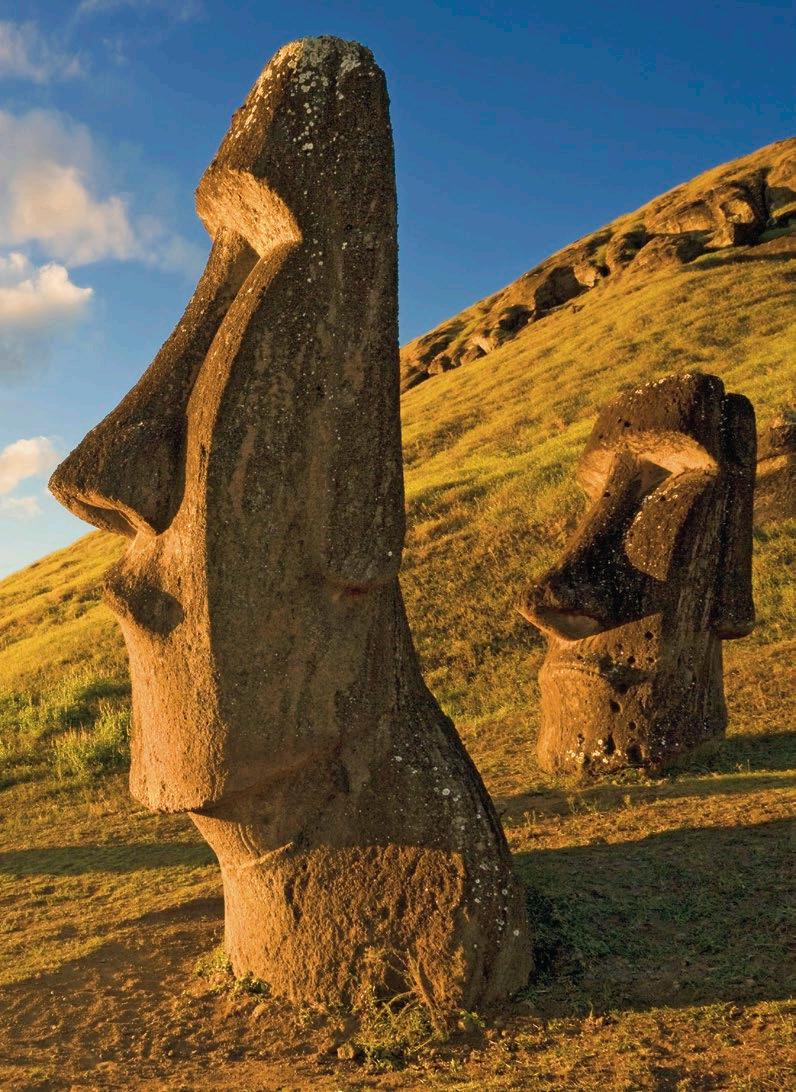 PHOTO: © GETTY IMAGES
PHOTO: © GETTY IMAGES

what they represent. Some researchers believe that they formed part of a cult of the dead and depict former chieftains or deified ancestors. Another mystery surrounding the figures—which are made from tuff and can stand up to ten metres high and weigh more than 80 tons—is how they were transported to their final locations. Only the island’s native Rapa Nui inhabitants are certain of the answer to this puzzle. According to them, the moais walked there!
HIGH UP IN THE PERUVIAN ANDES, around 2,400 metres above sea level, stands the regal Machu Picchu. Blending in perfectly with the subtropical vegetation, it’s thought that the “old peak” was built by the Incas in around 1450 as a royal retreat.
A century or so later, the Spanish would conquer South America and almost entirely wipe out the Inca civilisation. For almost 400 years, this rock city up in the clouds lay completely forgotten. It wasn’t until 1911 that the US explorer Hiram Bingham arrived at the city and brought it to the attention of the wider world.
THE GREAT SPHINX OF GIZA was hewn from a limestone hill in Egypt nearly 5,000 years ago. Legend has it that the Sphinx appeared to the young Prince Thutmose in a dream. It promised him that if he cleared away the sand that was burying its body, he’d be rewarded with the kingship of Egypt. Having done as he was bid, Thutmose did indeed become Pharaoh.


No one is certain about the meaning of the gigantic stone cat, although researchers think that this 20 metrehigh and 75 metre-long lion with a human head was built to guard the pyramid of the Pharaoh Khafra.
FEW PLACES have had so many stories surrounding them as Stonehenge. Could this stone circle be an ancient observatory, an enormous calendar, a place of pilgrimage, or even a landing site for UFOs?
According to the experts, the stone circle in southern England formed the centre of a ritual landscape. This interpretation is supported by the numerous burial mounds surrounding the megalithic monument. Nevertheless, the fact is that, even today, the 40 or so bluestones have yet to reveal all of their secrets. Only the age of the site has been determined beyond any
doubt—building commenced about 5,000 years ago and lasted for around 1,600 years.
MOUNT RUSHMORE, one of the world’s largest stone sculptures, has depicted important icons of American history since its completion in 1941. Gutzon Borglum created a memorial for posterity by carving the images of four of America’s greatest presidents into South Dakota’s Black Hills. Looking down from the huge granite cliff are the faces of (left to right) George Washington, Thomas Jefferson, Theodore Roosevelt and Abraham Lincoln, each of them about 18 metres high!
But no ordinary chisel sufficed for Borglum to create these sculptures—he started by blasting the rough outlines of the presidents’ features out of the rock with dynamite!
PHOTOS: (STONEHENGE) © TONY HOWELL/GETTY; (MOUNT RUSHMORE):© GETTY IMAGES/INGRAM PUBLISHING
 BY CATHY ADAMS
BY CATHY ADAMS

Cathy has danced in Rio, been microlighting in South Africa and hiked the mountains of Oman
Tell us about your favourite holiday (send a photo too) and if we include it on this page we’ll pay you £50. Go to readersdigest. co.uk/ contact-us
Sorrento is famous for the limoncello produced in the region
Joyce Fennell from Milton Keynes picks up on the scent of Sorrento
WITH A DILEMMA: do I maximise the opportunity to soak up as much culture as possible, or just relax? I needn’t have worried in Sorrento. It surpassed all expectations.


I was on a singles holiday in the Campania region of southern Italy. In Sorrento, we visited the Museo Correale di Terranova, a fascinating museum overlooking the Gulf of Naples. However, it was how we arrived there, and its setting, that will always stay with me.
From our hotel—the centrally located Zi Teresa—we walked along the main street, the Corso Italia. Stepping up to the right, we entered a citrus grove. It was like going back in time in an instant—from the busy, noisy road to a place of peace and sensory delights. The fragrance of the lemon and orange trees was heavenly.
Four hundred yards on, we entered a small courtyard, and tasted the famed liqueur— limoncello—produced locally for centuries.
The Museo Correale di Terranova, across the road, was set in beautiful gardens that wound slowly down to the sea, bordered by oleander bushes, roses and buddleia. To the side, a secluded garden overlooking the sea beckoned. As we entered, the overwhelming sense of tranquillity


almost knocked me backwards. I was so enthralled that I decided to return alone later that day to soak up the atmosphere again.
On another day, we visited the island of Capri. Few perhaps have heard of Anacapri, a village at the very top of the island. Here lies a still-active old perfumery, situated in a garden full of all kinds of scented plants—the basic ingredients for the many fragrant essences produced.
easyJet flies to Naples from £50.49pp one way (easyjet.com). Sorrento is just over 30 miles from Naples. Rooms at the Zi Teresa hotel start from around €100 (£87) a night (hotelziteresa.it, +39 081 878 46 19).

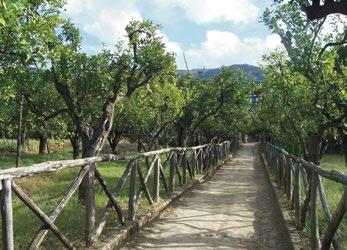

ON AUGUST 21, a solar eclipse will roar a diagonal stripe across America. One of the best places to see it is Wyoming’s Grand Teton National Park. Twin this with exploring the Cowboy State through majestic national parks, or get a taste of the Wild West in Jackson and Buffalo.
AmeriCan & Worldwide Travel offers an eight-night RV holiday from £2,090pp (01892 779 900, awwt.co.uk).

■ SEE: ELVIS PRESLEY’S MEMPHIS All eyes are on Memphis, Tennessee this month as the city remembers the King on the 40th anniversary of his death. Visit Elvis Presley’s Memphis at Graceland, which incorporates exhibitions, museums and restaurants (graceland.com).
■ STAY: THE PEABODY This legendary hotel treads a line between historic and cosmopolitan. If you’re not staying, come for the famous Peabody Duck March, which takes place twice a day. Twin rooms start from £101pppn (0333 323 9099, northamericatravelservice.co.uk).
■ EAT: BARBECUE The southern state is world-famous for its barbecue. Alongside blues, Central Beale Street is home to a handful of excellent restaurants: try Alfred’s On Beale or King’s Palace Café (memphistravel.com).
SHORT: Orcas in Iceland Spot pods of orcas, seals and dolphins amid lava fields and glacier-topped volcanoes— as well as the incredible Northern Lights. Dive Worldwide offers the four-night Orcas & Northern Lights trip from £1,475pp (01962 302 087, diveworldwide.com).
TRAVEL
APP OF THE MONTH

Companion, Free, Android, iOS. Solo travellers can instantly contact friends or police if they feel nervous in an unfamiliar destination. Reassuring.
LONG: The big five in South Africa
The big five and other predators prowl the vast grasslands of the 10,500-hectare Lalibela Game Reserve. Cedarberg Africa tailormake three-night safaris to the Game Reserve from £1,216 per person (cedarberg-travel.com, 020 8898 8533).






































Corsica may not readily reveal its charms— but that’s what makes it so alluring
BY MICHAEL PATERNITI
The dramatic coastline of Scandala Nature Reserve on Corsica’s west coast
WE FELL IN LOVE WITH THE ISLAND OF CORSICA on the fourth day. Prior to that, we—my wife, Sara, and I— weren’t certain about Corsica, nor she about us. The island, known by the French as l’Île de Beauté, came recommended for its many romantic attributes: granite mountains plunging into the sea, the siren scent of its maquis. We knew a bit about Corsica’s fascinating history, invaded by the usual line-up of ungenerous European plunderers, but still unshakably itself; and its people, imbued with a stubborn determination to remain free.
Flying from Paris, we harboured certain, though. Her route, while stunning, turned into a six-hour journey of coastal switchbacks, swerves, and nerves. Around every hairpin, it seemed, we were greeted by aggressive rally cars—Porsches, Citroëns, Volkswagens—there for that weekend’s Tour de Corse.
fantasies of the famous Corsican white-sand beaches, but our first vision of the island was the plane arching through grey cloud, ushering us to the rugged shoreline and Ajaccio, the island’s capital and Napoleon’s birthplace.
Our greeting party consisted of a woman at the Avis desk. With an impassive expression and dark, flashing eyes, she seemed not just exasperated, but offended by our very appearance. Could she be blamed? It was the end of tourist season, and she’d clearly reached her wit’s end. We, meanwhile, were hungry, tired, and headachy. We asked about the quickest route to Calvi, a beach haven about 45 miles up the western coast. She pointed abstractedly to a map.
“Follow signs,” she said.
“What signs?”
“Out the airport. Right, left. Sign to Calvi,” she said. Hovering above the map, her finger mimed circles of confusing squiggles. She seemed
This was the first truth we learned about the island: there are few straight roads, literal or figurative.
CORSICA LIES SOUTH of Genoa, 50 miles at its closest from the Italian mainland, and just seven miles north of the island of Sardinia. “Colossal undulations of earth,” Guy de Maupassant once wrote about the island, “covered with maquis or tall chestnut and pine forests.” He thought that the Corsicans were “an uncultivated race, bloody, hateful, violent without conscience; but also hospitable, generous, devoted and naïve.”
Designated today as one of the 13 regions of France, but ruled for large

swathes of its early history by Italy, Corsica is nearly two-thirds the size of Northern Ireland. It’s the ultimate study in dichotomies, not just temperamentally but in terms of landscape: coruscated mountains; parched scrub-covered desert; verdant lowlands; soft, sandy beaches; pine-thicketed valleys.
Though the southern coast of Corsica is the most traversed by tourists, the historic town of Calvi is one of the most popular destinations on the western coast, located in the Balagne region, with its olive trees and red granite. Calvi has hosted invaders since the Greeks arrived in the sixth century BC, leading to a saying in Corsica, which seems a strange boast: “Often conquered, never enslaved!”
The weather was described by the concierge at our hotel as going “from summer to winter in two days.” The next day, conditions were wet and wild, dragging palm fronds across the pool deck, though every once in a while, sunlight would illuminate the town’s dramatic fortress at the mouth of the harbour. The beautiful bay at Calvi, with its two-mile beach, was empty and moody.
With widespread flooding on the island, and the big road rally delayed, we lingered, walking the town’s narrow streets. Lunch was casual and languorous, at a place called A Piazzetta on a tucked-away plaza overflowing with flowers. Bibbed and smiling, Sara vanished into a heap of fresh pasta and tender Corsican prawns; I had the entrecôte
in green-pepper sauce. There was a leafy green salad, red wine and the local Pietra beer.
Right there, in that restaurant of red-chequered tablecloths and quaint signs, clocks, and colanders on the wall, we’d found the perfect Corsican marriage of France and Italy.
After wandering in the rain, we drove up through l’Île Rousse, a seaside town founded by the great
WE EASED PAST THE ‘ROAD CLOSED’ SIGN. I GUNNED THE CAR A LITTLE, RAN THE FIRST BIG PUDDLE AND THEN ANOTHER
car a little, ran the first big puddle and then another, and once the road began to climb we were fine, relieved, and coursing with adrenaline. Now we were the rally drivers.
There was no pain in arriving at that night’s hotel, a renovated 17thcentury palace named U Palazzu Serenu. The owner, Georges Barthes (nephew of the French literary critic Roland Barthes), has created an oasis of eight rooms in a three-story Florentine pile, remade into a hip enclave with contemporary art and a gourmet restaurant. The sockless but impeccable Barthes was both a delight and an enigma.
“I like to walk alone in the desert,” he said, “for months.” This was followed by, “I made my little fortune in roses.” He said no more.
patriot Pasquale Paoli, where everyone defiantly smoked in the bars despite the “no smoking” signs. We drove on to the Désert des Agriates (a shrubby landscape buzzing with the bees of the sweet-smelling maquis), then to port Saint-Florent and, finally, to the mountain village of Oletta.
AS IT TURNED OUT, a washed-out road now stood between us and our night’s lodging. To circumvent it would mean more hours of hairpins and switchbacks, so we eased past the “road closed” sign. I gunned the
As we ate in the hotel restaurant, four men wearing matching black vests walked in. They were friendly— irrepressible, actually. Italians.
It would soon become apparent that they were part of a rally team led by one of the Prada family of Milan. The men were miserable about the conditions—and complained about the “impossible” weather and the “unkempt” roads.
The team said they’d be on their way by 6am. Yet, when we left them at midnight, it seemed they were just getting started. Anyone for dessert? “Of Corsica!” said the team manager in theatrical, heavily accented English, and they broke out laughing.

ON THE THIRD DAY we woke late and threw open the shutters to a view down the mountain of the ocean. We took a leisurely drive to Saint-Florent, wandering the picturesque quays and eating fish fresh from the boat.
On the fourth day, a crisp wind stirred the pines, but it was warm in the sun. After breakfast, we drove to a vineyard in nearby Patrimonio, the Domaine Orenga de Gaffory, where we met the owner, Henri, and his exuberant wife, Anne. In 1872, Henri’s great-great-grandfather invented a world-famous, bittersweet aperitif known as Cap Corse Mattei made from grape must, oranges and quinine, and today the family produces 18 wines on 208 acres. They helped make the wines that
led to Patrimonio receiving its own appellation in 1968, but it still stings that it didn’t come sooner, as viticulture on the island is as old as the Greek traders who brought it here in 570 BC. “It’s an outrage,” Henri said, as if the matter had been settled yesterday. His Corsican pride didn’t seem exaggerated or unreasonable. Excellence was his obsession.
We toured the winery and sipped the wines, which were fantastic. By the time we’d finished, we were invited back to the Orenga de Gaffory home for lunch.
It’s said that to find the real Corsica, you need to travel inland, away from the waterfront restaurants and hotels with their Egyptian-cotton sheets, down the back roads and up
the ravines. You have to get a little dirty, and eat the food of the land. We drove the potholed road with Anne, who proclaimed, “It’s wonderful to live in the vines!” We bounced deeper into the grapes until we came upon the house: a stone building filled with copious fine contemporary art, much of which was Corsican.
Soon the four of us were seated at a long table, and out came a feast: fried aubergine, rice, crusty bread and, for spreading, an orange brick of poutargue—a strong, salty jelly-butter consisting of fish eggs that tasted delicious. One of the neighbours had shot a wild boar and the meat, sliced and tender, had an earthy smokiness. Consuming such strong flavours, while gazing out the window at the vines undulating like a sea of their own, I felt my defenses crumbling, and there it was: a sudden rush of love for Corsica.
Henri claimed that the most notable attribute of the Corsican people is protective behaviour towards others. He spoke of the devastation that followed the First World War, when many men left the island to fight and never returned. “The economy was destroyed; chestnuts became our potatoes.”
Famine followed, and Corsica shifted from patriarchy to matriarchy. “Even today,” he said, “the men are macho; the women hold the power.”
In his library, shelves sagging with
old books, Henri pulled various tomes from their places, revealing family trees and mysterious scripts. In some cases, the books dated back to the 17th century, the pages nearly disintegrating in hand.
GETTING THERE: Corsica has four international airports and ferries from cities in France and Italy
HOTELS: Domaine de Murtoli, Sartène, murtoli.com, doubles from 170 euros (1,100 in high season); U Palazzu Serenu, Oletta, upalazzuserenu.com, doubles from 170 euros; Les Roches Rouges, Piana, Gulf of Porto, lesrochesrouges.com, doubles from 125 euros
DINING: A Piazzetta, Calvi, traditional dishes, facebook. com/apiazzetta.calvi, entrees 15–40 euros; La Gaffe, SaintFlorent, quayside, ultrafresh catch of the day, restaurantsaint-florent.com, entrees 17–29 euros; La Grotte, cave turned candlelit restaurant on the Domaine de Murtoli estate, open daily June–October, murtoli.com, menu 80 euros
WINERY: Domaine Orenga de Gaffory, Patrimonio, orengadegaffory.com
In that room was the history of his country, the intensity of its passions, the continuum of his forebears. These people had been here all along, while invaders and day-trippers revolved through, trying to get closer to the simple grain of Corsican life.
“If I’m gone from here—and the vines—more than three days,” Henri said, “I can’t breathe anymore.”
WITH THE TIME LEFT to us, we made a mad, final swoop south—passing through Corte. The city lies in the furrow of two mountains and is considered the centre of the island. While not exactly stylish, it possesses that electric current of Corsica. We’d found the country wearying at times, but constantly breathtaking.
Which is what made our last destination, the Domaine de Murtoli, near Sartène in the south, such a surprise. It was a decadent paradise: almost 6,200 acres of mountain, beach, and farm, overseen by the Canarelli family on their ancestral estate. Installed in our 16th-century villa, we peered down at the oak trees in the valley below. We could have settled in for a long time, we said. Become Corsican.
The next day, we drove down winding roads to reach the whitesand beach at last. We lounged, ate and swam. That night, dinner at the stunningly restored farmhouse was lamb, fresh from the farm. Then we retired and woke before the sun, realising the dream was over.
When we returned the car at the Avis desk, our friend was there again. We were leaving, and she was staying. The island was hers, though we had a deep yearning to come back.
When we returned to Corsica, she’d have to reckon with our bumbling, but also our feelings for her—the bittersweet home of Napoleon Bonaparte, of Pasquale Paoli and, yes, the woman at the Avis counter.
It was the best kind of love, though—an unfinished story.
Imagine a world without hypotheticals. You can’t.
SOURCE: MICHAEL WORKMANAnother property may be an attractive prospect— but make sure you’re aware of the pitfalls

Andy Webb is a personal finance journalist and runs the awardwinning money blog Be Clever With Your Cash
For a huge chunk o F the population, particularly those under 35, getting on the housing ladder feels like a fantasy that will never happen. Yet homeownership has never been higher for Brits over 45, with more than 70 per cent having a place they can call their own.
And in this older group there will be people with not one, but two properties—perhaps more.
They’re not all going to be landlords, though many will be. Some will have a place to escape to on weekends; others might have kept a property when they moved in with their partner; or perhaps it might have been inherited. Maybe it’s simply where the kids are living while they’re at university.
Whatever the reason, if you’ve got a second home or are thinking of investing in one, it’s likely you see it as a nest egg to top up your retirement. In theory, keeping hold of it and cashing in later on will give you a better quality of life or care as you get older.
They can be a great investment—but there are extra costs associated with having one, particularly following some recent changes for

landlords. Here are a few things you should consider.
It’s bad news if you’re renting out your second home. Since April this year, new tax rules mean that buy-tolet homeowners can no longer offset 100 per cent of the interest from their mortgage against profits. It’ll be gradually dropping over the next few years and by 2020 the tax relief will be zero, and a new 20 per cent tax credit will be introduced. So not only will your tax bill jump up, but your profits could also fall. You could even potentially make a loss each year.
We know things go wrong with our homes, and the same will be true for second properties. Bear in mind you’ll need to pay for any repairs or improvements necessary.
And it’s not just maintenance you need to budget for. Whether it’s a holiday home or buy-to-let, you’ll need to make sure the property is insured. If the property is likely to be empty for long periods each year, you’ll probably need a specialist insurance policy.
Plus there are bills. If it’s not rented out, you’ll need to pay Council Tax, and you’ll probably want to have electricity, gas and a phone line, if not internet connection. Though you can
get pay as you go plans for your energy, and even some broadband providers, these are still costs you’ll need to cover throughout the year.
When you sell your second home, you need to pay Captial Gains Tax (CGT) on profits made. That’s currently 18 per cent, or 28 per cent if you’re a higher- or additional-rate taxpayer. There’s a CGT allowance each year of £11,300, but anything above this will be taxed.
If instead you were thinking of leaving it to your kids, they wouldn’t need to pay CGT, but the value would be included as part of your estate for inheritance tax purposes.

If you’re thinking of buying a second property, it’s not just the aforementioned costs you need to consider. there’s an additional three per cent added to stamp Duty for anyone who already has a home.
It’s not just shopping—my mum’s also on the ball when it comes to suspect emails
My MuM isn’t just savvy with her shopping, as my previous columns have shown. She’s also pretty smart when it comes to scams, particularly online. She can spot a dodgy email a mile off.
Recently she printed off three different emails to show me what she was receiving. At first sight they

seemed legitimate. One from NatWest declared an “E-statement is ready to view”. The second informed her that there were “2 unread secured messages” waiting in her BT account. The final email said Barclays were experiencing issues with systems, which meant that “some accounts were overdrawn”.

The problem was that these emails weren’t from NatWest, BT or Barclays. If my mum had clicked on the links in the emails, she’d have potentially allowed scammers to steal her login details—and her money.
So how did she know they were fake? They certainly looked like the real thing. There were no spelling errors (one telltale sign), and the wording and style emulated other authentic messages.
The giveaway came when looking behind the name in the “From” field to read the actual email addresses. Here it became clear the emails had been sent by scammers. The addresses didn’t say @BT.com or @natwest.com. Instead they were @utoronto.ca or @vt.edu.
It’s a cunning trick that you need to ensure you don’t fall for.
MY MuM’s MONEY tip:
With any email you get, especially those asking you to click on a link, check that the email really is from who it claims to be.
D o you hire help? Here are the top ten jobs we pay others to do for us:
DIY (29%)
Manage investments (22%)
Deliver takeaways (18%)
Arrange a mortgage (17%)
Book a holiday (16%)
Give a guided tour (14%)
Provide financial advice (12%)
Find insurance cover (9%)
Do the gardening (8%)
Clean the house (7%)



Of thE MONth:
Quidco & topcashback
quidco.com
topcashback.com


money for nothing seems too good to be true, but cashback has earned me hundreds of pounds in the last year.
Quidco and topcashback are the two main cashback websites, and through them you can get anything from ten per cent back from hotel bookings to hundreds back when switching internet provider. most major retailers are listed, including marks & spencer, expedia and Boots.
you search the cashback site for the retailer you want, check the cashback rate and see if there are any restrictions, then simply click through to the shop you want to spend money at. once you’ve completed the transaction, you’ll get your cut paid into your cashback account.
keep in mind money can take weeks to process, and if you don’t follow the rules, such as closing down other web pages, you could find your purchase doesn’t track—meaning you don’t get your money.

Rachel Walker is a food writer for numerous national publications. Visit rachel-walker.co.uk for more details
THIS TURKISH DISH literally translates as “the Imam fainted”—such is the sheer joy that it was said to elicit. It’s easy to see why, particularly at this time of year, when bulbous aubergines are at their best and the silkysoft flesh tastes so decadent.
Traditional recipes scoop out the cooked aubergine flesh and restuff the skins, but I find it less fiddly to stack everything on top of each other. It’s a great vegetarian dish to have up your sleeve, and will have meat-eaters salivating too.
Serves 2 (easily scalable)
• 2 aubergines
• 4tbsp olive oil
• 2–3 garlic cloves, crushed
• 1tsp paprika
• 1tsp ground cumin
• 400g chopped tomatoes
1. Preheat the oven to 200C.
• 1tsp dried oregano
• 1tsp sugar
• ½tsp salt
• 3-4tbsp plain yogurt
• 2tbsp parsley, sliced
• 1 can chickpeas (optional)
2. Halve the aubergines lengthways, cutting through the stalk and leaving it attached. Use the tip of a sharp knife to score a criss-cross pattern across the flat surface of the aubergine—this will help the heat penetrate the thickest part of the flesh. Drizzle half the olive oil (2tbsp) over the

aubergine and season with salt. Roast for 20–25 minutes in the hottest part of the oven, until the skin has darkened and the flesh is soft and collapsing.
BY TIM & ZOË HILL3. Meanwhile, heat the remaining olive oil in a saucepan. Keep back ½tsp of the crushed garlic, and cook the rest of it in the oil— on a gentle heat, so it’s aromatic but not coloured. Stir in the paprika and cumin, and add the tin of tomatoes, oregano, sugar and salt. Bring to a gentle simmer,

and leave it to reduce—with the lid off—while the aubergines are cooking. The finished sauce should be dark red, without any residual moisture. (You can add the can of chickpeas here if you like, to bulk it out.)
These portions are perfect for a light lunch. Serve as part of a mezze for a more substantial meal—along with pitta bread, tabbouleh and perhaps some falafel or halloumi.
4. In a small dish, mix the remaining garlic with the yogurt, and season with salt and pepper.
5. Arrange the two aubergine halves on each plate, and spoon the spiced tomato sauce over them. Top with garlicyogurt, and sprinkle with fresh parsley.
More often than not, you get to “try before you buy” when shopping. You’d never pick a perfume without sampling a spritz, or choose a new pen without having a scribble. A good cheesemonger will always offer a nubbin and most ice-cream parlours will do a little sample if you’re torn between flavours.
It’s not so easy with wine, though. Once the cork has been popped, it’s too late. It’s frustrating if you splash out on a bottle only to discover—too late—that you don’t like the tipple inside. Technology is changing this though, with more and more Enomatic machines appearing in wine shops. The vending machine-like wine dispenser allows samples of wine to be extracted, without the rest of the bottle oxidising, meaning that retailers can have a nice bottle on offer for weeks.
Customers put money on a store card, and can buy several tasters until they find the bottle for them.
London chain The Sampler often has 80 different bottles in Enomatic machines—meaning that

thirsty shoppers shouldn’t go on an empty stomach. Birmingham wine shop Loki offers samples from 69p, and Edinburgh-based Vino is a step ahead of most off-licences thanks to their Enomatic machine.

Perhaps most surprising is how Britain’s oldest wine shop, Berry Bros & Rudd, have embraced the modern technology in their new shop (63 Pall Mall, London). Their samples start at £1 a pop, though discerning customers might also pay £7.50 for a 25ml sample of 1990 Cos d’Estournel, St Estèphe. It might seem steep for a taste, but it retails at £220 per bottle. Now, that’s surely worth a try before you buy!

If you have squidgy, over-ripe raspberries, then the best thing you can do is cook them. A compote or crumble is great for using up leftover fruit, but nothing beats a fruit muffin, straight out of the oven.
• 150g plain flour
• 1½tsp baking powder
• 75g butter, softened
• 75g caster sugar
• 2 eggs, whisked
• 100–150g raspberries
1. Preheat the oven to 180C and grease a muffin tin (or line with muffin cases).
2. Sift the flour and baking powder into a large mixing bowl. Make a well in the middle and then tip in the egg, sugar and butter.
3. Quickly beat the mixture until combined, and then put in the raspberries.
4. Divide it between the holes in the muffin tray, and then cook for 20–25 minutes.

The Wine Dine Dictionary by Victoria Moore, £13.60. An A–Z of inspired wine and food pairings.

Suck UK Cork Bottle Light, John Lewis, £6.99. A pretty lantern, perfect for an outdoor soirée.

Coravin Model 2, Selfridges, £249. Pour your wine by the glass, without pulling the cork.

Lynda Clark is a homes, property and interiors expert, and editor of First Time Buyer magazine
WHEN THE WEATHER IS WARM and the days are long, nothing beats packing up some delicious food and going on a picnic. Essential items include a rug, bottle opener, corkscrew, cutting board, plastic plates, cups, cutlery and, of course, a bin bag.
If you’re feeling particularly adventurous, you could even bring a firepit—a free-standing open fireplace in which you can burn untreated wood. As well as providing warmth (in case in gets chilly), some models can also be used like a traditional barbecue.
Pedestal firepit, £59.99; bamboo cookware range, from £1.49; LED camping lantern, £7.99; glass hurricane lantern, £9.99; black solar lantern, £20; Solar multicoloured bulb lights, £12.99; geraniums, from £3.99.
■ All available from Dobbies (dobbies.com)
Enjoy the great outdoors with these practical yet pretty accessories.
■ Fold-up camping lamp, £3, flyingtiger.com

■ Red roses picnic rug, £65, thegardenhouse.net
■ Picnic hamper, £59, marksandspencer.com
■ Globe firepit with cooking grill and mesh lid, £80, wyvalegardencentres.co.uk




Gothic and Roman diamond trellis arches are ideal for supporting roses and twining plants. The larger, double-framed arches span wider paths and are strong enough to support heavier climbers such as wisteria. Garden Requisites (gardenrequisites.co.uk) make arches, gates and trellis panels to measure. They source solid steel from British suppliers and each structure is hot-dip galvanized to a recognised British Standard. Beautiful.

Reclaimed wooden furniture can add a lovely, rustic look to your home—connecting your living space to the natural world.

A unique coffee table made from reclaimed boat timbers, £488 (alexanderandpearl. co.uk).

Made of 100-year-old reclaimed wood, this console table will suit any room, £229 (modishliving.co.uk).

An elegant wine rack made from reclaimed timbers, £260 (elementonehouse.com).
How have you lived without impressive concrete speakers and a quirky aromatherapy diffuser?

Olly is a technology expert, radio presenter and podcaster
MASTER AND DYNAMIC MA770 SPEAKER, £1,600
Concrete is durable and utilitarian. It’s also, I feel, grey and rather ugly. Still, fans of brutalism will reach for their wallets on sight of this novel multi-room speaker designed by Sir David Adjaye. It boasts room-filling sound and has serious heft—this is defiantly NOT a portable speaker. The dampening properties of the concrete reduce vibrations too—useful if you live in a flat. But I suspect you already know whether you want a concrete slab on your bookshelf, however artfully sculpted.


APPLE APP OF THE MONTH:
BABY MONITOR 3G, £3.99 Travelling with a baby can involve more kit than a U2 world tour, but at least now you can ditch the baby monitor. Using wi-fi or mobile

data, this app pairs any two iPhones, designating one as the “baby station” (which you leave beside the cot) and one as the “parent station” (which you take with you). So, when the baby needs a nap, you can survey them remotely.
When I was a kid, Clive James and Chris Tarrant made TV shows mocking the Japanese for having this sort of toot in their homes. But, while it may be a gimmick to add both a Bluetooth speaker and a colour-changing LED lamp to an aromatherapy diffuser, well...why not?
The concept is that the anxiety-soothing sounds and lights emit from the very same trinket circulating your essential oils— something for which you won’t have much need, unless you run a spa. But it’s good value and it made me smile. A small speaker will never sound great under 400ml of water, but as a diffuser and humidifier (its primary purpose), it’s decent.

Summer festivals are more popular than ever before, and if you’re familiar with the indignity of tripping over multiple guy ropes as you stumble back to your tent from a late-night toilet break, this is the gadget for you. Don the comfortable head strap and choose from two straightforward settings: high (all four LEDs) or low (just two). Also good for year-round outdoor sports such as riding and sailing, as it’s suitably water-resistant and drop-proof enough to survive the odd fall.


It’s amazing this hasn’t been done before—an app that lets you follow a lead vehicle’s route, even if you lose sight of them on the road. It’s a bit fiddly to sign up but, if you’ve got a procession of cars on a road-trip, it’s worth the effort. (Sure, you could just enter the destination into separate sat navs and arrive at roughly the same time—but you’d miss all the fun of stopping off at the same service station, wouldn’t you?)


Georgina is a fashion and beauty editor for numerous travel titles and a blogger at withgeorgia.com
If you InsIst on beIng a sun-worshIpper, you need to make sure you protect your skin before, during and after exposure. Jean-Noël Thorel, founder of skincare brand Institut Esthederm, has developed a three-step suncare regime that allows you to enjoy prolonged periods in the sun regardless of your skin type.
First, apply the the Bronz Impulse spray all over your body a few days before sunbathing—it’s designed to strengthen your skin’s natural defences. During sun exposure, use either the Adaptasun cream or the oil, depending on your skin type. Once you’re in the shade, apply the Prolongateur de Bronzage (tan-prolonging) body lotion liberally. All products in the collection are anti-ageing and stimulate the body’s defence system against UVinduced inflammation.
■ Available at spacenk.com
Pocket-sized anti-shine
■ If you refuse to hit the gym without make-up on, try the Murad MattEffect Blotting Perfector (£32, murad.co.uk).
It’s a liquid-to-powder formula that absorbs excess oil and sweat, leaving your make-up intact—perfect for the hot summer days!




■ Did you know your hair can be sunburnt just like your skin?
The new summer range from Philip Kingsley is geared up to protect your hair and repair your scalp during the hotter months. The Sun Shield (£22, philipkinglsey.co.uk) hair mist will also tame frizzy hair.


■ A black swimsuit makes for a sleeker silhouette (£29.50, marksandspencer.com).

■ This large, round cotton towel is the perfect shape for sharing with little ones (£55, amara.com).
■ Go from the beach to the beach bar with this chic cover-up (£69, monsoon.co.uk).


■ Keep the sun off— and look especially chic—with a stylish hat (£39, bimbaylola.com).
■ Say goodbye to novelty print swim shorts and be the smart guy at the beach (£10, marksandspencer.com).


■ Leather flip flops are a little more durable for walking on hard ground, as well as sand (£39.95, whitestuff.com).
Two literary superstars make a return this month with a thrilling Tudor epic and a moving portrait of a marriage

James writes and presents the BBC Radio
4 literary quiz
The Write Stuff
by Philippa Gregory (Simon & Schuster, £20)
Philippa Gregory’s latest Tudor epic begins with the story of Lady Jane Grey: pious, self-confident, scholarly—and completely out of her depth.
Aged 17, Jane is bullied into becoming queen by scheming courtiers, who clear off at the first sign of trouble, leaving her to her fate. Part Two is then narrated by Jane’s less famous sister Catherine, a far cheerier soul—until she offends Elizabeth I by getting married. In Part Three, it’s the turn of the youngest Grey sister, Mary, to face Elizabeth’s pitiless and apparently random disapproval.

As ever, Gregory does a particularly powerful job of showing how terrifying life can be when it’s entirely controlled by royal whim, with Elizabeth all the more sinister for remaining largely off-stage. The book also supplies a thorough guide to the complexities and often repetitive nature of Tudor politics—which proves both a strength and a weakness. On the one hand, we do learn a lot of interesting stuff. On the other, you can’t help thinking that if Gregory wasn’t such a best-selling literary superstar, a wise editor might well have suggested cutting a hundred pages or so.
NAME THE AUTHOR
(Answer on p128)
Can you guess the writer from these clues (and, of course, the fewer you need the better)?
1. He was born in Portsmouth in 1812.
2. He was the first novelist to appear on a British banknote.
3. The only one of his novels with no London scenes is Hard Times.

by Bernard MacLaverty (Cape, £14.99)
It’s been a while now since Bernard MacLaverty was something of a superstar himself. His two best-known books, Lamb and Cal—both reflecting his Northern Irish background and both made into successful films— were published in the early 1980s. But in his first novel for 16 years, he provides thrilling proof that he’s lost none of his ability to tackle big issues in a way that’s unfailingly quiet and unfussy, but that ends up being completely piercing.
In Midwinter Break, the issues in question are mostly domestic. Gerry and Stella have been married a long time, on the whole happily. These days, though, Stella is finding Gerry’s drinking and general descent into grumpy male old age increasingly hard to take. The tensions finally come to a head during a short holiday to Amsterdam, where he spends too much time in an Irish bar. Yet, after so many years together, even the couple’s arguments are somehow companionable, with Gerry acting as Stella’s chief confidant in her complaints about him.
The result is a pin-sharp but ultimately compassionate portrait of the frustrations and pleasures of a long marriage—and of how closely the two things are linked. Well worth the wait.
n Cartes Postales from Greece by Victoria Hislop (Headline Review, £7.99) Another rich and classy piece of commercial fiction from the best-selling Hislop, complete with her usual irresistible sense of place.
n The People at Number 9 by Felicity Everett (HQ, £7.99)
Needy Sara discovers that her cool new neighbours aren’t all they seem in a darkly unsettling domestic thriller.
n Culloden by Trevor Royle (Abacus, £12.99) Clear, readable and informative account of the Jacobites’ crushing final defeat— and what it meant for Britain.
n The Man in the Middle by Howard Webb (Simon & Schuster, £8.99) Fascinating and convincing insight into what it’s like to be a football referee. (Not easy, apparently.)
n Bolshoi Confidential by Simon Morrison (4th Estate, £9.99) Jaw-dropping history of the Russian ballet company, with plenty of scandal amid the glory. If there’s such a thing as beautifully researched gossip, this is it.

Legendary Scottish actress Phyllida Law talks about love, acting and alcoholic monkeys in her new memoir RD’S RECOMMENDED READ
PHYLLIDA LAW, it’s hard to avoid the words “national” and “treasure”. Now 85, she’s been appearing in British theatre and on British television since the 1950s. For 25 of those years, she was married to Eric Thompson, writer and narrator of The Magic Roundabout, until his death in 1982. Their daughters Sophie and Emma Thompson are—as you probably know—actresses too.

Law’s previous two books concerned her family. Now she looks back on her early days in the theatre, culminating in a hugely touching account of her and Eric’s courtship and wedding. Before that, though, we get a funny and charming guide to

Dead Now Of Course by Phyllida Law is published by Fourth Estate at £12.99.
the vanished theatrical world of 1950s Britain: a place of seedy digs, fierce landladies and stage-door johnnies bearing bunches of flowers. At times, Law seems almost disbelieving herself that such a world could ever have existed.
Dead Now Of Course—the title referring to many of the people she mentions—is possibly not a book for those readers who like memoirs to be tightly structured. Instead, Law leaps from one subject to another in the manner of an unusually entertaining, if rather eccentric, conversationalist talking about whatever happens to cross her mind.
Along the way, we do hear about
some of her more memorable roles— from performing in Shakespeare’s Henry VIII for the Queen and Winston Churchill to playing the back end of a pantomime cow (commonly known in the business as “the udder half”). But she mainly concentrates on the strange off-stage life of the time—as in this passage about “the most notorious landlady in London”, Norma Sheila Peta Miller, also known as Mildew. Mildew’s house, incidentally, is “demolished now of course”…
Somehow, she knew everyone, even the Kray brothers. She said they had the cleanest fingernails she’d ever seen. I don’t know how she knew them. I didn’t ask. She also knew assorted aristocrats. I asked about that. Her husband, Able Seaman Dusty Miller, was a prisoner of war, who had escaped so regularly they’d had to put him in Colditz. And everyone in Colditz had connections at the Court. Interesting people with terrifying voices and no money. Dusty didn’t have any either. By trade, he was a heating engineer and Norma Sheila Peta helped finance his workshop with her property deals. Her house had a shifting population, composed of actors in the attic, a couple of criminals, several dogs, an alcoholic monkey and a prostitute.
I used to call to visit the actors on the top floor. If N.S.P. Miller wasn’t
n Bring on the Empty Horses by David Niven The sequel to The Moon’s a Balloon sees Niven in Hollywood during its Golden Age—and more than willing to spill the beans about what he found there.
n Wishful Drinking by Carrie
Fisher Not one for the fainthearted. Fisher tells of her rackety life with great candour, but—despite plenty of opportunity—not a trace of self-pity.
n The Richard Burton Diaries
Intimate account of Burton’s life—with, not surprisingly, especial emphasis on his tempestuous relationship with Elizabeth Taylor.
n Is It Just Me? by Miranda Hart Firmly in the Phyllida Law mould, with lots of selfdeprecating anecdotes and a nicely chatty tone.
n I, an Actor by Nicholas Craig
Craig doesn’t really exist: he’s a comic creation by Nigel Planer, who here gives us a devastating and very funny parody of actors at their most self-important.
in, they threw the key down in an old sock. If she was, and answered the door, she looked like Marlene Dietrich from the waist up and an unreliable charlady from the waist down, wearing socks and pink mules.
the local pub. In time, he became famous for his hangovers and his ability to escape to the roof. Mildew had a very close relationship with the local firemen.
There used to be a zoo in Harrods—you could, apparently, order a camel and get it delivered
I was fascinated by the stories the boys used to tell me. I wanted so much to meet the monkey, which N.S.P. Miller had bought from Harrods. There used to be a zoo in Harrods. You could, apparently, order a camel and get it delivered. Mildew bought Chico because he looked so utterly miserable and took him home via the vet, where he was diagnosed with ‘borderline pneumonia’. ‘Give me your hand,’ the vet said to Mil, and when he took it, he snipped a three-inch cuff off her cardigan and made two tiny holes at each side, thus creating a Chicosized jumper.
Chico survived on a regime of port and brandy. He even had his place in

AND THE NAME OF THE AUTHOR IS…
Charles Dickens—who was on the £10 note from 1992 to 2003.
(Hard Times is set in the industrial north.)
Chico lived in a huge cage in the bathroom with a tiny duvet, where he used to retire, red-eyed, from the pub. His favourite friend was a mildmannered mongrel called Mick the Greek, on which he would ride round the house, side saddle, holding onto his collar with one hand, and waving at his fans with the other.
Finn McCool, the Irish Wolfhound, was huge. He used to glare at people through the letterbox with his golden eyes. He was epileptic, and if he took a turn on the top landing, his descent was epic.
I never met Bitos, the Afghan hound, known as The Flying Duster. Just as well. He used to bite people on the nose if he smelt alcohol.
I don’t know what happened to the dogs. I do know that Chico fell in love with Mildew and became aggressive to any other males of whatever sort, belting them with poo, aimed unerringly through the bars of his cage. In the end, he went to a retirement home. For monkeys.

Karin Slaughter is the internationally best-selling author of more than a dozen novels, and is one of the most popular crime writers working today. Her new book The Good Daughter is out now.
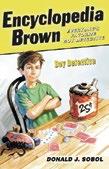
Encyclopedia was this super-smart kid who solved mysteries with Sally, his friend and sidekick. But I would get really annoyed that she was never allowed to be quite as clever as him—and there began the stirrings of feminism in my eight-year-old mind. Sometimes I could figure out the puzzles before Encyclopedia and a little seed was planted about the importance of female protaganists.
My favourite scene is when Scarlett shoots dead the Yankee who breaks into Tara, where she’s living with Melanie. Up to this point Scarlett hasn’t had much time for

Melanie—she married Ashley Wilkes, who Scarlett believes herself in love with—but when Melanie appears beside her with a sword in case the Yankee needs finishing off, their relationship changes. It was an important lesson to me; it showed how violence can be used to reveal character. It can tear people apart but also bring them together.

I was always interested in the darker side of life. I once taped Marilyn Monroe’s autopsy photograph onto my lunch box. My parents were called in to school but my father just said, “She’s always been weird, leave her alone.” I read Flannery O’Connor at 12 years old and loved that she wrote about unusual people—those who were dislikable and cruel. As told to Caroline Hutton
Win £50 for your true, funny stories! Go to readersdigest. co.uk/contact-us or facebook.com/readersdigestuk
I WAS ON THE PHONE to my seven-year-old grandson Tom about a special day trip he took with his school. “It was brilliant,” he exclaimed. “But have you heard the bad news?”
As I waited with bated breath, he announced, “I heard my fidget spinner won’t be arriving from Amazon for another two weeks!”
CHRISTINE EDNEY, West Sussex
DURING THE HOLIDAYS, my cousin and I were visiting our grandparents’ house when we spotted a spider in the bathroom.
Afraid of spiders, my cousin decided not to wear her glasses when she went to the toilet because, as she reminded me, “Ignorance is bliss.”
SAFIYYAH ESAT, Leicestershire
I WAS LOOKING FOR a new suit when, inevitably, I was approached by an obsequious salesman. The last time I’d bought a suit I’d benefited from a special offer and acquired two at a discount. It was, therefore, some time since my last purchase.

“Thirty-nine long, please,” I said as I had for many years. The salesmen glanced at my thickening waist for a fraction of a second and smiled.
“Oh, Sir,” he said sympathetically. “Those were the days.”
FRANK PEIRSON, Oxfordshire
MY THREE-YEAR-OLD has a cuddly cow that he takes everywhere with him. After a particularly muddy morning spent outside, he held the
thing up and said, “Look at this lovely cow, he’s all grubby!”
I agreed that the cow was indeed grubby and then my son asked in an earnest voice, “But how did all the grubs get on him?”
JENNIE GARDNER, SomersetMY DAUGHTER-IN-LAW works in the shop at a zoo. One day a father came to the counter with his young son and a stuffed toy bird. He asked if the bird came in blue because he didn’t want his son buying something pink as it was too “girlish”.
My daughter-in-law told him that it only came in pink and the annoyed father protested, “Why?”
She replied patiently, “Because it’s a flamingo, Sir.”
LORETTA JENKINS, North WalesALONG WITH A BUS LOAD of tourists, we travelled to Runnymede. We gathered around the guide who explained, “This is the spot where the barons forced King John to sign the Magna Carta.”
A man at the front of the crowd asked, “When did that happen?” “1215”, answered the guide.
The man looked at his watch and exclaimed, “Gee whizz, we just missed it by a half hour.”
BETH WEBB, DenbighshireI WAS HAVING A DRINK at my neighbour’s barbecue, when I was cornered by an insufferable woman
whose sole joy in life was to brag about her daughter.
Nothing was beyond this child. Her current passion was gymnastics. Needless to say, she was in training for the 2020 Olympics. My eyes had glazed over by this point, so she tried to engage my seven-year-old nephew who was fidgeting at my side.
“Have you got a gym in your school, Stephen?”
He looked up at her with a confused frown and said slowly, “No,” and then, eager not to disappoint, he continued, “But we’ve got an Achmed!”
PATRICIA SANDERS, Cambridgeshire
WHILE VISITING our daughter, who’d just had a baby, we met a man in the lift on the way to the maternity ward holding a pink ceramic boot filled with some imitation flowers and a chocolate selection.
My wife smiled and said “That’s lovely.” And then added, “Does she look like you?”
He stared at us and retorted, “I certainly hope not. I’m the courier.”
PAUL AINSWORTH, Manchester
I WAS HAVING A BAD DAY and my husband was getting under my feet, even though I’d told him I’d prefer if he didn’t go out.
In the end I shouted to him, “You should go out and give me a break.”
He came back two hours later with a Kit Kat for me! I had to smile.
JOANNEAITCH
, Wirral





As a print subscriber, you’re helping Reader’s Digest—still the largest circulating paid-for magazine in the world—continue to enlighten, educate and entertain readers the world over with content you can trust
Why not explore some of the great o ers on our website and discover even more benefits by being part of the Reader’s Digest community?
Say hello to love with Reader’s Digest Dating
A seamless dating experience for mature singles looking for companionship.
readersdigestdating.co.uk
Sell your home the easy way... with Reader’s Digest Property
Sell your house for cash, in a hassle-free process and on a timescale to suit you.
readersdigest.co.uk/property
...or release some of its value with Reader’s Digest Equity Release The easy way to free up the funds to change your life, and keep your home.
readersdigest.co.uk/equity-release
Sail away into the sunset with Reader’s Digest Cruise Club
Join the club for free for access to a dedicated consultant and bespoke cruise packages.
readersdigest.co.uk/cruiseclub
Protect your property... with Reader’s Digest Insurance
Get peace of mind with an insurance product tailored to suit your needs.
readersdigest.co.uk/money/insurance
...and your rights with Reader’s Digest Legal
From making a claim to writing your will, we have the informed advice you need.
readersdigest.co.uk/legal
As a thank you for being part of the timeless Reader’s Digest community, we’re o ering over £80 o the Joan Collins
Timeless Beauty Collection
We’re o ering eight best-selling products from the range—usually worth over £109. This unmissable o er is exclusive to Reader’s Digest readers
Simply visit us at readersdigest.co.uk/timeless to claim now for only £24.99*
Plus £4.99 packing and postage
it pays to increase your
Some Native American words adopted into English are as common as a garden chipmunk (that’s from the Ojibwa tribe), but there are plenty that are as unusual as a manatee in a mackinaw. For answers and etymology, turn to the next page.
By Emily Cox & H E nry r at H von1. mackinaw n —A: mountain creek.
B: makeshift bed. C: wool coat.
2. dory n —A: dry gulch. B: flatbottomed boat. C: small red potato.
3. hogan n —A: town meeting.
B: log home. C: ceremonial pipe.
4. punkie n —A: wooden sled.
B: biting bug. C: runt of a litter.
5. dowitcher n —A: wading bird.
B: widow. C: gifted healer.
6. Podunk n —A: small town.
B: swimming hole. C: fried cake.
7. manatee n —A: carved face.
B: sea cow. C: hard-fought contest.
8. pogonip n —A: ball game.
B: organic snack. C: cold fog.
9. potlatch n —A: straw hat.
B: particularly vivid red pigment.
C: celebratory feast.
10. kachina n —A: rain shower.
B: wooden doll. C: drum.
11. savanna n —A: voyage on foot.
B: expression of adoration.
C: grassland.
12. terrapin n —A: spring flower.
B: swampland. C: turtle.
13. hackmatack n —A: larch tree.
B: machete. C: ambush.
14. sachem n —A: hex or curse.
B: puff of smoke. C: leader.
15. chinook n —A: convicted thief.
B: warm wind. C: campfire between two rocks.
1. mackinaw —[C] wool coat. “Joseph always wears his mackinaw, even on warm, sunny days.” (Algonquian)
2. dory—[B] flat-bottomed boat. “Susan’s favourite way to relax is fishing from her dory on the bay.” (Miskito)
3. hogan—[B] log home. “The doorway of a traditional hogan faces east, toward the sunrise.” (Navajo)
4. punkie—[B] biting bug. “Whether you call them midges, no-see-ums, or punkies, they’re all out for blood!” (Delaware)
5. dowitcher—[A] wading bird. “According to my field guide, that bird is a long-billed dowitcher.” (Iroquois)
6. Podunk—[A] small town. “Who could have imagined that this kid from Podunk would make it big?” (Algonquian)
7. manatee—[B] sea cow. “Manatees use their flippers to ‘walk’ along the seabed while grazing on plants.” (Cariban)
8. pogonip—[C] cold fog. “Thanks to this morning’s pogonip, I have ice crystals in my eyebrows.” (Shoshone)
9. potlatch—[C] celebratory feast. “Jake’s sausage casserole is a favorite at his family’s annual potlatch.” (Nootka)
10. kachina—[B] wooden doll. “The museum has an impressive collection of hand-carved kachinas.” (Hopi)
11. savanna—[C] grassland. “On his tour of African savannas, Eli spotted elephants, zebras, and rhinos.” (Taino)
12. terrapin—[C] turtle. “On summer days, terrapins sun themselves on flat rocks in the marsh.” (Algonquian)
13. hackmatack —[A] larch tree. Will you have a picnic under the hackmatack with me? (Algonquian)
14. sachem—[C] leader. “The CEO may sit in the corner office, but in this company the marketing director is the real sachem.” (Narragansett)
WorD oF tHE Day*
tHEStrEEn
Last night. alternative suggestions:
“an actor in training.”
“Weightlifters take this when they lift something really heavy.”
“the street opposite the strand.”
15. chinook—[B] warm wind. “The chinook blew in from the southwest, melting the last of the winter snow.” (Chehalis)
voCaBUlary ratinGS
9 & below: rough translator
10–12: smooth interpreter
13–15: native speaker
Smartphone technology is evolving every day, with an ever-increasing range of functions and uses becoming available from handsets.
For one manufacturer however, with all of the research and development into technical improvements, its most important evolution has been the addition of simplicity.
Doro, the world leader in easy-to-use mobile phones, has worked hard to make smartphone technology accessible to all— regardless of age or ability. The Doro Liberto® 820 Mini is a powerful smartphone, with all the functionality of the competition
Buy a new Doro Liberto® 820 Mini smartphone today, for the special price of £150—which includes an Anywhere SIM card connection and £40 of credit— allowing you to roam the UK with signal from O2, EE, Three and Vodafone.
PLUS, if you buy now, you will receive a protective cover for your phone (rrp £20) ABSOLUTELY FREE.
Simply go to readersdigest.co.uk/ mobilephones or call 03454 133 953 and quote “Reader’s Digest o er”.
on the market, but because of its simple and highly visual instructions, a smartphone novice will be able to do more, and at a quicker pace.
Large icons clearly identify where to find each function—from making a call, to sending a message or accessing the internet—the 820 Mini has a simple logic. It also has loud and clear sound, and is hearing aid compatible.
In addition, for each of the main functions, there are step-by-step guides built into the phone to help the new user get familiar with the technology at their own pace.











Challenge yourself by solving these puzzles and mind stretchers, then check your answers on p139.
Domino arithmetic
Two dominoes have been set on a piece of paper with arithmetic symbols drawn on it so as to create an equation (26 − 25) whose answer is one. How could you use the same two dominoes in a similar fashion to make an equation whose answer is two?
aGe Unknown
Francesca is as old as the combined ages of her two brothers, Harry and Ernie. Harry is two years younger than Ernie. When everyone was a year younger, the combined ages of the three siblings was three-quarters of the sum of their present ages. How old is each sibling now?
sUit YoUrselF
The playing-card suits in the cells below are placed according to a pattern. What’s the missing symbol?
Jake loves steak; trish loves Fish
Jacob enjoys steak so much that the probability that he’ll have it for dinner on any given evening is one in three. The favourite dish of his wife, Patricia, is fresh fish. The probability that she’ll have it for dinner on any given evening is one in two. Because Jacob and Patricia always dine together, they’ll never have steak and fish on the same night. On average, how many times in a 30-day month will they be having either steak or fish?
two oF a kinD
Divide this rectangle into three sections by drawing three straight lines meeting at right angles. Each section should contain two of the six different figures: two smiley faces, two hearts and so on.
Brainteasers: Answers
Domino arithmetic
52 ÷ 26.
aGe Unknown
Francesca is six years old, Harry is two and Ernie is four.
sUit YoUrselF
. Each suit has a numerical value: diamonds equal one, hearts equal two, spades equal three and clubs equal four. Or, if you prefer, diamonds equal four, hearts equal three, spades equal two and clubs equal one. Either way, each row and column adds up to 10, and the missing symbol is a spade.
Jake loves steak; trish loves Fish
25 nights.
two oF a kinD
answer to JUlY’s prize qUestion 30 years. Planet a travels 360 ÷ 16 = 22.5 degrees around the circle every year. Planet b travels 360 ÷ 20 = 18 degrees around the circle every year.
Hence, a gets farther ahead of b by 22.5 – 18 = 4.5 degrees every year.
£50 prize qUestion
answer published in the september issue
Which of the four figures below completes the set?
the first correct answer we pick on august 2 wins £50! email excerpts@ readersdigest.co.uk
the planets will be in a straight line with the sun (but on opposite sides) once a is an additional 180 – 45 = 135 degrees ahead of b. this will take 135 ÷ 4.5 = 30 years.
anD the £50 Goes to… John renel, north Yorkshire
Win £50 for every reader’s joke we publish! Go to readersdigest. co.uk/contact-us or facebook.com/readersdigestuk
I DID REALLY WELL at secondary school. I was a prefect, head girl and a star athlete.
Of course, those are just some of the perks of being homeschooled.
SEEN ONLINE
I THINK ANIMAL TESTING is a terrible idea. They get all nervous and give the wrong answers.
COMEDIAN PETER KAY
GOT THE WRONG NUMBER?
$17.31
DO YOU THINK that the Queen ever pulls the duvet cover right up to her head and says, “Philip! Look at me, I’m a stamp!”
COMEDIAN RUSSELL HOWARD
MY BROTHER JUST broke my favourite lamp.
I’m not sure I’ll be able to look at him in the same light again.
COMEDIAN GARY DELANEY
...is the amount of money a Texan man decided to sue his date for after she annoyed him by texting while they were in the cinema. He won the payment in full.
Source: telegraph.co.uk
I USED TO WATCH the Royal Variety Performance every year with my family—it was a tradition. And now I’m on the stage doing it myself. I’m sure wherever my father is, he’d be looking down on us.
He’s not dead, he’s just incredibly condescending.
COMEDIAN JACK WHITEHALLA PSYCHIATRIST WAS talking to a new patient. “Your form says you’re here because your family is very worried about your taste in socks. Is that right?”
“Yes, that’s right,” replied the patient. “I only like wool socks.”
“But that’s perfectly normal,” replied the psychiatrist. “Many people prefer wool socks to those made from cotton or acrylic. In fact, I myself like wool socks.”
“You do?” Exclaimed the patient. “With oil and vinegar or just a squeeze of lemon?”
TRACY DAVIDSON, WarwickshireYESTERDAY AT A JOB interview, I filled my glass of water until it overflowed a little.
“Are you nervous?” asked the interviewer, kindly.
“No,” I replied. “I always give 110 per cent.” SEEN ONLINE
MY BLOODY NEIGHBOUR banged on my door at 2.30 this morning.
Thank God I was still up playing the drums.
COMEDIAN JO BRAND
These local newspaper headlines are hilariously underwhelming (as seen at thepoke.co.uk).




I MOVED TO NEW YORK recently and yesterday outside the Comedy Club, some teenagers asked me if I knew where the nearest pizza place was. It felt great because I figured I must seem like a real New Yorker.
But then I realised I must just look like somebody who would know where the nearest pizza place is.
MY NAME IS NICHOLAS but you can call me Nick.
It’s my nickname.
THEY STOPPED SELLING my favourite deodorant the last time I was at the supermarket, so I had to pick a new one. All they had was “Max Sport 48 Hour”.
It’s good marketing I guess. If you’re spending your weekend wrestling, you want a powerful deodorant.
I think what I really need is “16 Hour Netflix-Binge-Watching Protection”. I’d probably still get “Max Sport” though—I’m too embarrassed to be caught with that kind of truth in my basket.
SEEN ONLINE
DO YOU HAVE any idea how long I spent searching for my wristwatch this morning?
Because I don’t.
SEEN ONLINE
I SAW ARNOLD SCHWARZENEGGER eating a chocolate egg.
I said, “I bet I know what your favourite Christian festival is.”
He said, “You have to love Easter, baby.”
COMEDIAN TIM VINE
The people of Twitter share the scenarios that leave Britons reeling:
@LouiseASmith: “Choosing the wrong items for a meal deal and having to pay £10 for a bottle of water, a sandwich and a Twix.”
@DSanderson1982: “The taking-one-step-off-a-busy-tube-and-onto-theplatform-and-STOPPING move.”
@GaryHolc: “The idiot who doesn’t abide by the ten items or less rule in the supermarket queue.”
@MyFabuluxeLife: “When somebody mishears your name and you have to accept that you will now forever be known by your new name.”
@RolyUnGashaa: “When someone puts milk in first when making tea.”
We chatted with well-spoken funnyman,
WHAT’S YOUR FAVOURITE OF YOUR OWN JOKES?
When I moved house I teamed up with a white girl, an Asian girl and a black guy, and we moved into the front cover of a university prospectus.

WHAT’S THE BEST PART OF YOUR CURRENT SET?
I’ve got a bit on that awful statistic about how many spiders you eat in your sleep every year. All we ever think about is how horrible that is for humans, but we forget it’s also just really embarrassing for spiders.
HAVE YOU FOUND PARTS OF THE COUNTRY FUNNIER THAN OTHERS?
The friendliest city is definitely Birmingham. They’re up for a laugh from any end of the spectrum.
ANY MEMORABLE HECKLES?
During one of my early gigs, a guy got up and started using the fruit machine next to the stage. There’s no bigger silent criticism.
DO YOU HAVE A FUNNY TALE ABOUT A TIME YOU BOMBED?
One Scotland show was so brilliantly silent that I started to question whether there was actually anyone

in the audience. At the end I asked them to boo me off, and they didn’t even do that. They could at least have thrown some assorted vegetables.
IF YOU WERE A FLY ON THE WALL, WHOSE WALL WOULD YOU BE ON?
The Dalai Lama because I know he wouldn’t swat me.
IF YOU COULD HAVE A SUPER POWER, WHAT WOULD IT BE?
I’d be a wi-fi hotspot.
“Glenn Moore: The Very Best of Belinda Carlisle” is being performed at Edinburgh Fringe Festival throughout this month

Think of a witty caption for this cartoon—the three best suggestions, along with the cartoonist’s original, will be posted on our website in midJuly. If your entry gets the most votes, you’ll win £100.
Submit to captions@readersdigest.co.uk or online at readersdigest.co.uk/caption by xxx We’ll announce the winner in our October issue.

Another month, another defeat for our poor cartoonist! His caption, “Yes, we’re outsourcing our security service”, won just 12 per cent of the votes. The victor, by contrast, won over an impressive 40 per cent of voters with the line, “Well, you wanted stronger border controls.” Congratulations, David Taylor!
As ever, thank you to all who entered and all who voted. Will the cartoonist have better luck next month? Check back here to find out!

The TV presenter on work, sacrifices and first dates

The incredible architecture that’s keeping us safe
• How To Sleep More
• Best of British: Retreats
• “I Remember”: Jennie Bond


